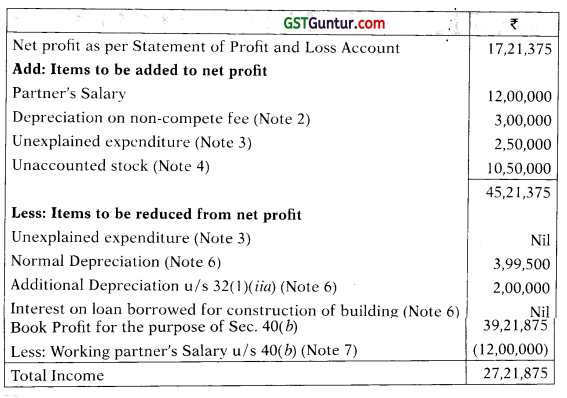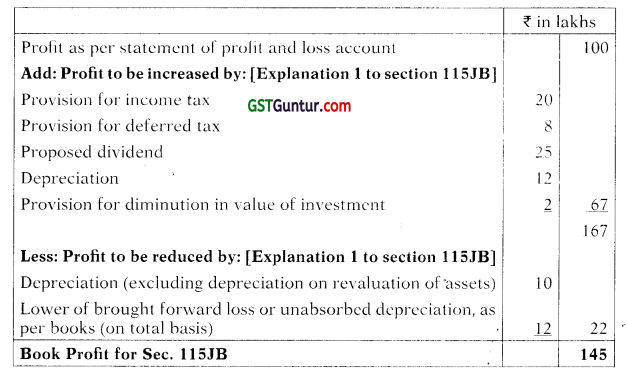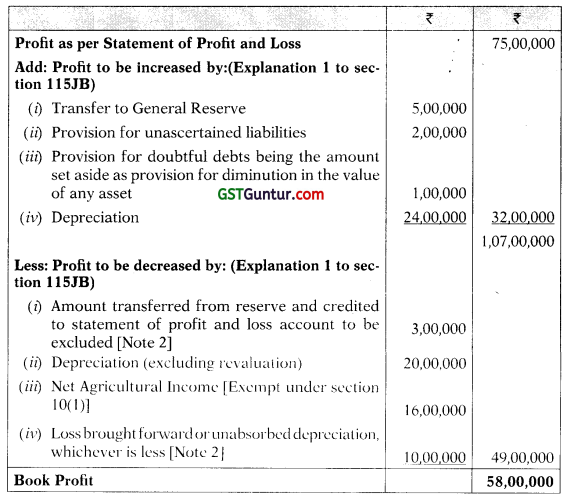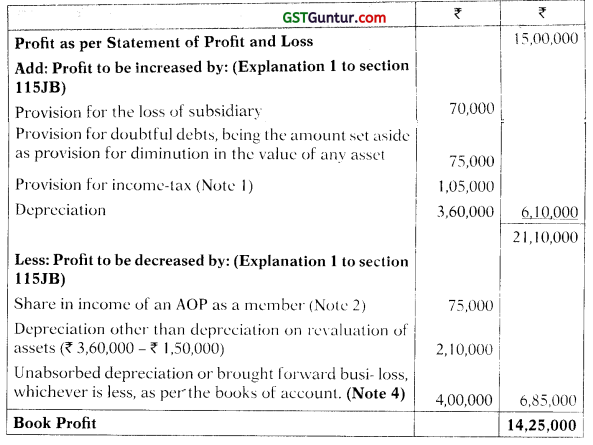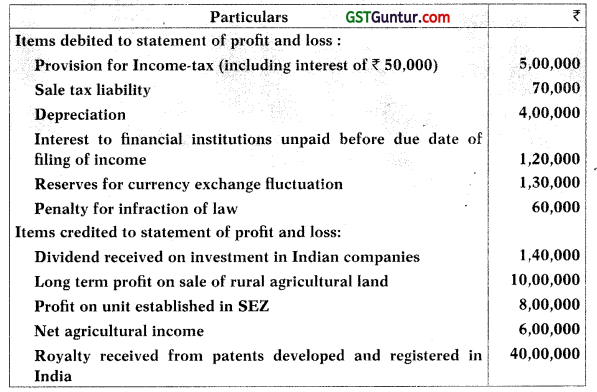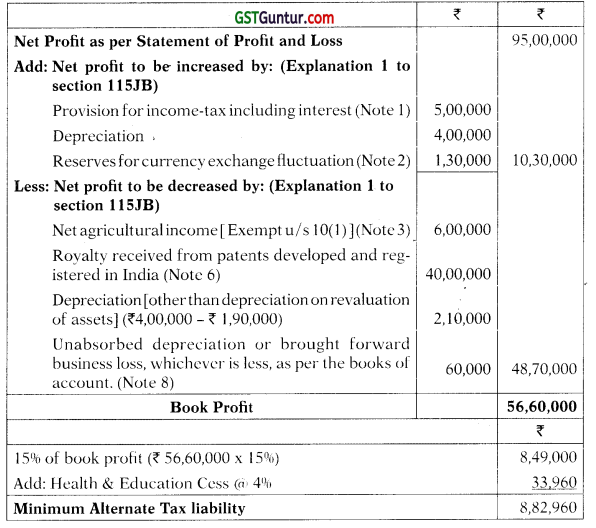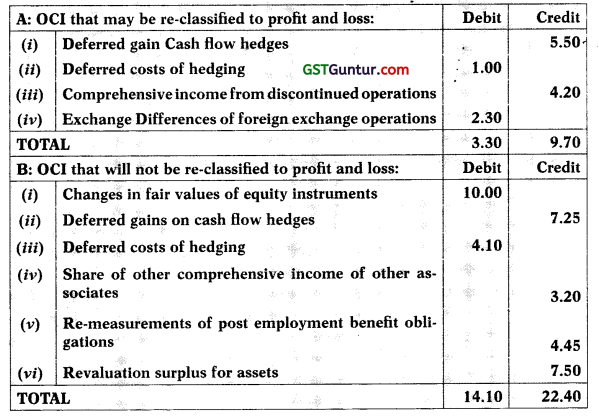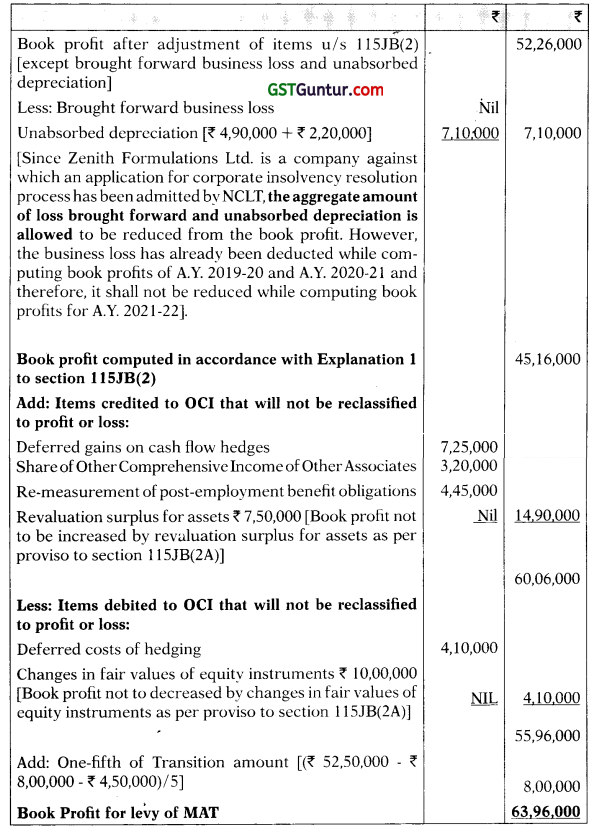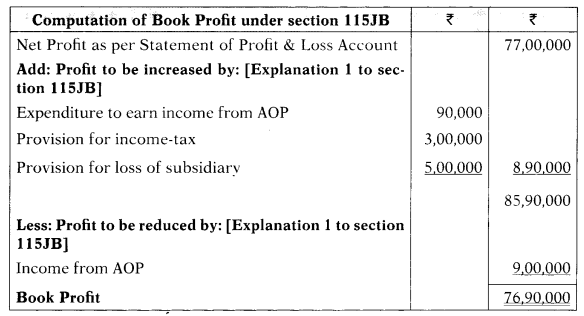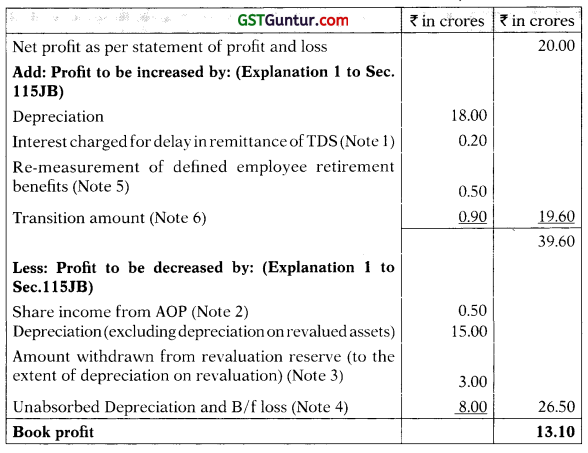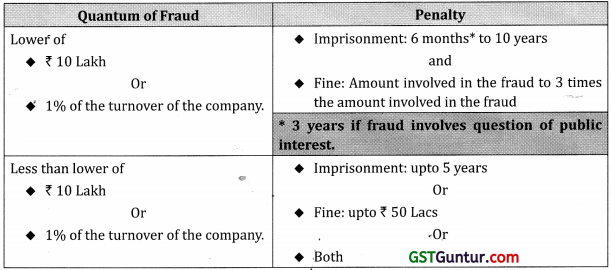Mergers, Acquisitions and Corporate Restructuring – CA Final SFM Study Material is designed strictly as per the latest syllabus and exam pattern.
Mergers, Acquisitions and Corporate Restructuring – CA Final SFM Study Material
Part-1(Theory)
Question 1.
Write short note on Horizontal Merger and Vertical Merger. [May 2016] [4 Marks]
Answer:
A merger is generally understood to be a fusion of two companies. It may be classified as horizontal merger or vertical merger.
Horizontal Merger: Under this type of merger, the two companies which have merged are in the same industry. Normally the market share of the new consolidated company would be larger and it is possible that it may move closer to being a monopoly or a near monopoly to avoid competition.
Vertical Merger: This merger happens when two companies that have ‘buyer- seller’ relationship (or potential buyer-seller relationship) come together.

Question 2.
What are the problems for “Merger and Acquisitions” in India? [Nov. 2016] [4 Marks]
Answer:
The following are the problems of mergers and acquisitions in India:
- Controlling Interest: The Indian companies are largely promoter-controlled and managed.
- Legal Compliances: There are strict SEBI rules and regulations. In addition, the need for ‘prior negotiations and concurrence of financial institutions and banks’ also creates problem.
- Funding Problem: The reluctance of financial institutions and banks to fund acquisitions directly.
- Exit Policy: There is a lack of exit policy for restructuring or downsizing of schemes of mergers and acquisitions.
- Valuation Problem: The absence of efficient capital market system makes the market capitalisation not fair in some cases. The fair valuation of entity is still creating hurdles.
Question 3.
Explain “Synergy” in the context of Merger and Acquisitions? [Nov. 2012] [4 Marks]
Answer:
The one of the most common reasons for Mergers and Acquisition (M&A) is Synergistic operating economics. In simple terms, synergy implies that one plus one is more than two. In terms of mergers and acquisition, if V (A) and V (B) denote the Values of two Firms ‘A’ and ‘B’ then following shall prevail:
V (AB) > V (A) + V (B)
In other words the combined value of two firms or companies shall be more than their individual value. The ‘Synergy’ is the increase in performance of the combined firm over what the two firms are already expected or required to accomplish as independent firms. The synergy benefits arise due to following:
1. Economics of combined efforts: A company may have a good networking of branches and other company may have efficient production system. Thus, the merged companies will be more efficient than individual companies.
2. Economies of scale: The economies of large scale are also one of the reasons for synergy benefits. The main reason is that, the large scale production results in lower average cost of production e.g. reduction in overhead costs on account of sharing of central services such as accounting and finances, office executives, top level management, legal, sales promotion and advertisement etc.
3. Real and Pecuniary Economies: The economics can be “real’’ arising out of reduction in factor input per unit of output, whereas pecuniary economics are realized from paying lower prices for factor inputs for bulk transactions.
Question 4.
How synergy is used as a tool when deciding merger and acquisitions? – [May 2017] [4 Marks]
Answer:
The mergers and acquisitions are made with the goal of improving the company’s financial performance for the shareholders. The shareholders will benefit if company’s post-merger share price increases due to the synergistic effect of the deal. The expected synergy achieved through the merger can be attributed to various factors, such as increased revenues, combined talent and technology or cost reduction.
The two businesses can merger to form one company that is capable of producing more revenue than either could have been able to independently or to create one company that is able to eliminate or streamline redundant processes, resulting in significant cost reduction.
When two companies merge to create greater efficiency or scale, it is called as synergy merge. It is clear the synergy may be used as a tool for deciding the merger or acquisition.
Question 5.
What is equity carve out? How does it differ from a spin off? [Nov. 2013] [4 Marks]
Answer:
Equity Carve out:
It is partial spin-off in which a company creates its own new subsidiary and subsequently brings out its IPO. The parent keeps a controlling stake in the newly traded subsidiary. A carve-out is a strategic avenue a parent firm may take when one of its subsidiaries is growing faster and carrying higher valuations than other businesses owned by the parent. A carve-out generates cash because shares in the subsidiary are sold to the public, but the issue also unlocks the value of the subsidiary unit and enhances the parent’s shareholder value.
Spin-off
In this case, a part of the business is separated and created as a separate firm. The existing shareholders of the firm get proportionate ownership. So there is no change in ownership and the same shareholders continue to own the newly created entity in the same proportion as previously in the original firm.
Difference between Equity Carve Out and Spin-Off
- Under spin-off, the shareholders in new company remain the same but not in case of equity curve out.
- Under Spin-off parent company does not receive any cash but equity carve-out generates cash because shares in the subsidiary are sold to the public.

Question 6.
Write short note on “Takeover by Reverse Bid”. [Nov, 2011, 2014, 2019] [4 Marks]
Answer:
Usually, a large company takes over smaller company. In a ‘reverse takeover’, a smaller company gains control of a larger one. The concept of takeover by reverse bid, or of reverse merger, is thus not the usual case of amalgamation of a sick unit which is non-viable with a healthy or prosperous unit but is a case whereby the entire undertaking of the healthy and prosperous company is to be merged and vested in the sick company which is non-viable. A company becomes a sick industrial company when there is erosion in its net worth. This alternative is also known as taking over by reverse bid.
Conditions for Reverse Takeover:
The following are the conditions of reverse merger:
(a) Value of Assets: The assets of the transferor company are greater than the transferee company,
(b) Value of Shares issued: The equity capital to be issued by the transferee company pursuant to the acquisition exceeds its original issued capital, and
(c) Controlling Interest: The change of control in the transferee company through the introduction of a minority holder or group of holders.
Question 7.
Write short note on “Financial Restructuring.” [Nov. 2008, May 2013] [4 Marks]
Answer:
When a company incurs continuous losses, the share capital or net worth of such companies gets substantially eroded. In fact, in some cases, the accumulated losses are even more than the share capital and thus leading to negative net worth, putting the firm on the verge of liquidation. In order to revive such firms, financial restructuring is one of the techniques to bring into health such firms which are having potential and promise for better financial performance in the years to come. Financial restructuring refers to a kind of internal changes made by the management in Assets and Liabilities of a company with the consent of its various stakeholders. With the help of restructuring, the firm re-starts with a fresh balance sheet free from losses and fictitious assets and show share capital at its true worth.
Normally equity shareholders make maximum sacrihce by foregoing certain accrued benefits, followed by preference shareholders and debenture holders, lenders and creditors etc. The sacrifice may be in the form of waving a part of the sum payable to various liability holders. The foregone benefits may be in the form of new securities with lower coupon rates so as to reduce future liabilities. The sacrifice may also lead to the conversion of debt into equity. Sometime, creditors, apart from reducing their claim, may also agree to convert their dues into securities to avert pressure of payment. These measures will lead to better financial liquidity. The financial restructuring leads to significant changes in the financial obligations and capital structure of corporate firm, leading to a change in the financing pattern, ownership and control and payment of various financial charges.
The financial restructuring results into the following:
(i) The reduction or waiver in the claims from various stakeholders.
(ii) The revaluation of various properties and assets of the entity.
(iii) The profit accruing on account of appreciation of assets is utilised to write off accumulated losses and fictitious assets (such as preliminary expenses and cost of issue of shares and debentures) and creating provision for bad and doubtful debts.
Part-2(Numerical Problems: Topic Wise In Chronological Order)
Question 1.
1K Ltd. is considering acquiring N. Ltd., the following information is available:

Exchange of equity shares for acquisition is based on current market value as above. There is no synergy advantage available:
(i) Find the earning per share for company K. Ltd. after merger.
(ii) Find the exchange ratio so that shareholders of N. Ltd. would not be at a loss. [Nov. 2008] [12 Marks]
Answer:
(i) Determination of new EPS of K. Ltd. after Merger:
| Exchange Ratio |
= \(\frac{\text { Market Value of } N \text { Ltd } .}{\text { Market Value of } K \mathrm{Ltd} .}\) = \( \frac{160}{200} \) = 0.8
[0.8 shares of K Ltd. for every 1 share of N Ltd.] |
| No. of shares to be issued |
= 2,50,000 × 0.8 = 2,00,000 Shares |
| Total Shares of K Limited (after merger) |
= 10,00,000 + 2,00,000 = 12,00,000 Shares |
| Total Profits of K Ltd. (After Merger) |
Rs. 50,00,000 + Rs. 15,00,000 = Rs. 65,00,000 |
| EPS of K Ltd. (After Merger) |
= \( \frac{R s .65,00,000}{12,00,000 \text { Shares }} \) = Rs. 5.42
|
(ii) Exchange Ratio so that shareholder of N. Ltd. would not be at a Loss:
The shareholders of N Limited would not be at loss if the exchange ratio is based on EPS.
|
K Ltd. |
N Ltd. |
| EPS before Merger |
= \(\frac{\text { Rs. } 50,00,000}{10,00,000 \text { Shares }} \) = Rs. 5.00 |
= \(\frac{R s \cdot 15,00,000}{2,50,000 \text { Shares }} \) = Rs. 6.00 |
Exchange Ratio (with EPS as base) = \(\frac{E P S \text { of } N \text { Ltd. }(\text { Target Co. })}{\text { EPS of } K \text { Ltd. }(\text { Acquirer Co. })}\)
= \(\frac{R s .6}{R s .5}\) = 1.2
It means 1.2 shares of K Ltd. for every 1 share of N Ltd.
Shares to be issued to N Ltd. = 2,50,000 Shares × 1.2 = 3,00,000 Shares
Total number of Shares = 10,00,000 + 3,00,000 = 13,00,000 Shares
EPS of K Ltd. (after merger) = \(\frac{R s .65,00,000}{R s .13,00,000}\) = ₹ 5.00
Verification that the shareholders of target company are not at loss:
Method 1 (Total Earnings approach)
Total Earnings available to Shareholders of N. Ltd,:
Before Merger = 2,50,000 Shares × ₹ 6.00 (EPS) = ₹ 15,00,000
After Merger = 3,00,000 Shares × ₹ 5.00 (EPS) = ₹ 15,00,000
Method 2 (EPS approach)
The EPS available to Shareholders of N. Ltd.:
Before Merger = ₹ 6
After Merger = EPS of K Ltd, after merger × Exchange Ratio = 5 × 1.2 = ₹ 6
Therefore, the exchange ratio on the basis of EPS is recommended.

Question 2.
You have been provided the following Financial data of two companies:
|
Krishna Ltd. (₹) |
Rama Ltd. (₹) |
| Earnings after taxes |
7,00,000 |
10,00,000 |
| Equity shares (outstanding) |
2,00,000 |
4,00,000 |
| EPS |
3.5 |
2.5 |
| P/E ratio |
10 times |
14 times |
| Market price per share |
35 |
35 |
Company Rama Ltd. is acquiring the company Krishna Ltd., exchanging its shares on a one-to-one basis for company Krishna Ltd. The exchange ratio is based on the market prices of the shares of the two companies.
Required:
(i) What will be the EPS subsequent to merger?
(ii) What is the change in EPS for the shareholders of companies Rama Ltd. and Krishna Ltd.?
(iii) Determine the market value of the post-merger firm: PE ratio is likely to remain the same.
(iv) Ascertain profits accounting to shareholders of both the companies. [Nov. 2009] [10 Marks]
Answer:
(i) Determination of new EPS subsequent to Merger:
| Exchange Ratio |
= \(\frac{\text { Market Value of Krishna Ltd. } . \text { Target Co.) }}{\text { Market Value of Rama Ltd. }}\) = \(\frac{35}{35}\) = 1
[1 share of K Ltd. for every 1 share of Krishna Ltd.] |
| No. of shares to be issued |
= 2,00,000 × 1 = 2,00,000 |
| Total Shares of Rama Limited (after merger) |
= 4,00,000 + 2,00,000 = 6,00,000 Shares |
| Total Profits of Rama Ltd. (After Merger) |
= (2,00,000 × 3.5) + (4,00,000 × 2.5) = Rs. 7,00,000 + Rs. 10,00,000 = Rs. 17,00,000 |
| EPS of Rama Ltd. (After Merger) |
= \(\frac{R s, 17,00,000}{6,00,000 \text { Shares }}\) = Rs. 2.83 |
(ii) Change in EPS for shareholders of both companies:

The exchange ratio is 1:1, therefore the new EPS of Rama Ltd. i.e. Rs. 2.83 need not to be adjusted while determining the impact on EPS.
(iii) Market Value of merged firm:
| P/E ratio of new firm (expected to remain same) |
14 times |
| New market price (14 × ₹ 2.83) |
₹ 39.62 |
| Total No. of Shares (4,00,000 + 2,00,000) |
6,00,000 |
| Total market Capitalization (6,00,000 × ₹ 39.62) |
₹ 2,37,72,000 |
| Existing market capitalization (₹ 70,00,000 + ₹ 1,40,00,000) |
₹ 2,10,00,000 |
| Total gain |
₹ 27,72,000 |
(iv) Determination of profits to shareholders of companies:


Question 3
MK Ltd. is considering acquiring NN Ltd. The following information is available:

Exchange of equity shares for acquisition is based on current market value as above. There is no synergy advantage available.
(i) Find the earning per share for company MK Ltd. after merger, and
(ii) Find the exchange ratio so that shareho1rers of NN Ltd. would not be at a loss. [Nov. 2010] [8 Marks]
Answer:
(i) Determination of new EPS of MK Ltd. after merger:
| Exchange Ratio |
= \(\frac{\text { Market Value of NN Ltd }}{\text { Market Value of MK Ltd. }} \) = \( \frac{160}{200} \) = 0.8
[0.8 shares of MK Ltd. for every 1 share of NN Ltd.] |
| No. of shares to be issued |
= 3,00,000 × 0.8 = 2,40,000 Shares |
| Total Shares of MK Limited (after merger) |
= 12,00,000 + 2,40,000 = 14,40,000 Shares |
| Total Profits of MK Ltd. (After Merger) |
Rs. 60,00,000 + Rs. 18,00,000 = Rs. 78,00,000 |
| EPS of MK Ltd. (After Merger) |
= \(\frac{\text { Rs. } 78,00,000}{14,40,000 \text { Shares }} \) = Rs. 5.42 per share |
(ii) Exchange Ratio so that shareholder of NN Ltd. would not be at a Loss: The shareholders of NN Limited would not be at loss if the exchange ratio is based on EPS.
|
MK Ltd. |
NN Ltd. |
| EPS before Merger |
= \(\frac{\text { Rs. } 60,00,000}{12,00,000 \text { Shares }}\) = Rs. 5.00 |
= \(\frac{\text { Rs. } 18,00,000}{3,00,000 \text { Shares }}\) = Rs. 6.00 |
Exchange Ratio (with EPS as base) = \(\frac{E P S \text { of } N N \text { Ltd } .(\text { Target Co. })}{\text { EPS of MK Ltd. }(\text { Acquirer Co. })}\) = \(\frac{\text { Rs. } 6}{\text { Rs. } 5}\) = 1.2
It means 1.2 shares of MK Ltd. for every 1 share of NN Ltd.
Shares to be issued to NN Ltd. = 3,00,000 Shares × 1.2 = 3,60,000 Shares
Total number of Shares = 12,00,000 + 3,60,000 = 15,60,000 Shares
EPS of MK Ltd. (after, merger) = \(\frac{R s .78,00,000}{15,60,000 \text { Shares }}\) = ₹ 5.00
Verification that the shareholders of target company are not at loss:
Method 1 (Total Earnings approach)
Total Earnings available to Shareholders of NN Ltd.:
Before Merger = 3,00,000 Shares × ₹ 6.00 (EPS) = ₹ 18,00,000
After Merger = 3,60,000 Shares × ₹ 5.00 (EPS) = ₹ 18,00,000
Method 2 (EPS approach)
The EPS available to Shareholders of NN Ltd.:
Before Merger = ₹ 6
After Merger = EPS of MK Ltd, after merger × Exchange Ratio = 5 × 12 = ₹ 6
Therefore, the exchange ratio on the basis of EPS is recommended.

Question 4.
Longitude Limited is in the process of acquiring Latitude Limited on a share exchange basis. Following relevant data are available:

You are required to determine:
(i) Pre-merger Market Value per Share, and
(ii) The maximum exchange ratio Longitude Limited can offer without the dilution of
(1) EPS and
(2) Market Value per Share
Calculate Ratio/s up to four decimal points and amounts and number of shares up to two decimal points. [May 2013] [8 Marks]
Answer:
(i) Pre-Merger Market Value of Share (in unit):
| Formula |
Longitude Ltd. |
Latitude Ltd. |
| P/E Ratio × EPS |
15 × Rs. 8 = Rs. 120 |
10 × Rs. 5 = Rs. 50 |
(ii) (i) Maximum Exchange Ratio without dilution of EPS:
The shareholders of Latitude Ltd. would not be at loss if the exchange ratio is based on EPS.
Exchange Ratio (with EPS as base)
= \(\frac{\text { EPS of Latitude Ltd. }(\text { Target Co.) }}{\text { EPS of Longitude Ltd. }(\text { Acquirer Co.) }}\) = \(\frac{R s .5}{R s .8}\) = 0.625
It means 0.625 shares of Longitude Ltd. for every 1 share of Latitude Ltd.
Shares to be issued to Latitude Ltd. = 16 Lakh Shares × 0.625 = 10 Lakh Shares
(ii) Maximum Exchange Ratio without dilution of Market Value per share: The shareholders of Latitude Ltd. would not be at loss if the exchange ratio is based on Market Price.
Exchange Ratio (with Market Price as base)
= \(\frac{\text { Market Price of Latitude Ltd. }(\text { Target Co.) }}{\text { Market Price of Longitude Ltd. }(\text { Acquirer Co.) }}\) = \(\frac{R s .50}{R s .120}\) = 0.4167
It means 0.4167 shares of Longitude Ltd. for every 1 share of Latitude Ltd.
Shares to be issued to Latitude Ltd.= 16 Lakh Shares × 0.4167 = 6,66,666.67 Shares
Alternative approach:
|
Longitude Ltd. |
Latitude Ltd. |
Total |
| Pre-merger |
= Rs. 120 × 15 Lakhs |
= Rs. 50 × 16 Lakhs |
Rs. 2,600 Lakhs |
| Market Capitalisation |
= Rs. 1800 Lakhs |
= Rs. 800 Lakhs |
|
Max. No. of Shares (After Merger)
= \(\frac{\text { Combined Market Capitalisation }}{\text { Current Market Price of Longitude Lid. }}\)
= \(\frac{R s .2600}{R s .120}\) = 21.67 Lakh Shares
Max. Shares no. be issued to Latitude Limited = 21.67 – 15 = 6.67 Lakh Shares
Therefore, the maximum share exchange ratio is 6.67:16 or 0.4169:1

Question 5.
Cauliflower Limited is contemplating acquisition of Cabbage Limited. Cauliflower Limited has 5 lakh shares having market value of ₹ 40 per share while Cabbage Limited has 3 lakh shares having market value of ₹ 25 per share. The EPS for Cabbage Limited and Cauliflower Limited are ₹ 3 per share and ₹ 5 per share respectively. The managements of both the companies are discussing two alternatives for exchange of shares as follows:
(i) In proportion to relative earnings per share of the two companies.
(ii) 1 share of Cauliflower Limited for two shares of Cabbage Limited.
Required:
(i) Calculate the EPS after merger under both the alternatives.
(ii) Show the impact of EPS for the shareholders of the two companies under both the alternatives. [Nov. 2014] [10 Marks]
Answer:
(i) Calculation of EPS after merger:
|
Alternative I (EPS Basis) |
Alternative II (Exchange Ratio 1:2) |
| Total Earnings (W.N.1) |
Rs. 34,00,000 |
Rs. 34,00,000 |
| Total Shares (W.N.3) |
6,80,000 |
6,50,000 |
| EPS of Cauliflower after Merger |
\( \frac{34,00,000}{6,80,000} \) = ₹ 5.00 |
\( \frac{34,00,000}{6,50,000} \) = ₹ 5.23 |
(ii) Merger impact of EPS for the shareholders of the two companies:
With EPS based Share Exchange Ratio:
|
EPS (Existing) |
EPS (After Merger) |
Change in EPS |
| Cauliflower Ltd. |
Rs. 5 |
Rs. 5 |
No Change |
| Cabbage Ltd |
Rs. 3 |
Rs. 5 × 0.6 = Rs. 3 |
No Change |
With Exchange Ratio of 1:2
| EPS |
Existing |
After Merger |
Change in EPS |
| Cauliflower Ltd. |
Rs. 5 |
Rs. 5.23 |
Increase [0.23] |
| Cabbage Ltd. |
Rs. 3 |
Rs. 5.23 × 0.5 = Rs. 2.615 |
Decrease [0.385] |
Note: While comparing the EPS (before and after merger) for the shareholders of target company (Cabbage Ltd.), the post-merger EPS has to be adjusted on the basis of Exchange Ratio.
Working Note-1 Calculation of total earnings
| Company |
Existing No. of Shares |
EPS |
Total earnings |
| Cauliflower Ltd. |
5,00,000 |
5.00 |
25,00,000 |
| Cabbage Ltd. |
3,00,000 |
3.00 |
9,00,000 |
| Total earnings |
|
Rs. 34,00,000 |
|
Working Note-2 Calculation of total shares to be issued to Cabbage Company:
No. of shares (EPS Basis) = Shares in Cabbage Ltd. × \(=\frac{\text { EPS of Cabbage }}{\text { EPS of Cauliflower }}\)
= 3,00,000 × \(\frac{\text { Rs. } 3}{\text { Rs. } 5}\) = 1,80,000 shares
No. of shares (ER 1:2) = Shares in Cabbage Ltd. × Exchange Ratio
= 3,00,000 × \(\frac{\text { Rs. } 1}{\text { Rs. } 2}\) = 1,50,000 shares
Working Note-3 Calculation of total number of shares
No. of shares after merger = 5,00,000 + 1,80,000 = 6,80,000
|
Alternative I (EPS Basis) |
Alternative II (Exchange Ratio 1:2) |
| Existing Shares |
5,00,000 |
5,00,000 |
| Fresh Shares issued |
1,80,000 |
1,50,000 |
| Total Shares |
6,80,000 |
6,50,000 |

Question 6.
East Co. Ltd. is studying the possible acquisition of Fost Co. Ltd. by way of merger. The following data are available in respect of the companies.
|
East Co. Ltd. |
Fost Co. Ltd. |
| Earning after tax (₹) |
2,00,000 |
60,000 |
| No. of equity shares |
40,000 |
10,000 |
| Market value per share (₹) |
15 |
12 |
(i) If the merger goes through by exchange of equity share and the exchange ratio is based on the current market price, what is the new earning per share for East Co. Ltd.?
(ii) Fost Co. Ltd. wants to be sure that the merger will not diminish the earnings available to its shareholders. What should be the exchange ratio in that case? [Nov. 2017] [8 Marks]
Answer:
(i) Determination of new EPS of East Ltd. (After Merger):
| Exchange Ratio |
= \(\frac{\text { Market Value of Fost Ltd }}{\text { Market Value of East Ltd. }}\) = \(\frac{12}{15}\) = 0.8
[0.8 shares of East Ltd. for every 1 share of Fost Ltd.] |
| No. of shares to be issued |
= 10,000 x 0.8 = 8,000 Shares |
| Total Shares of East Limited (after merger) |
= 40,000 + 8,000 = 48,000 Shares |
| Total Profits of East Ltd. (After Merger) |
Rs. 2,00,000 + Rs. 60,000 = Rs. 2,60,000 |
| EPS of East Ltd. (After Merger) |
= \( \frac{R s, 2,60,000}{48,000 \text { Shares }\) = Rs. 5.416 |
(ii) Exchange Ratio so that shareholder of Fost Ltd. would not be at a Loss: The shareholders of Fost Limited would not be at loss if the exchange ratio is based on EPS.
|
East Ltd. |
Fost Ltd. |
| EPS before Merger |
= \(\frac{R s .2,00,000}{40,000 \text { Shares }}\) = Rs. 5.00 |
= \(\frac{R s .60,000}{10,000 \text { Shares }}\) = Rs. 6.00 |
Exchange Ratio (with EPS as base) = \(\frac{\text { EPS of Fost Ltd. }(\text { Target Co.) }}{\text { EPS of East Ltd. }(\text { Acquirer Co. })}\) = \(\frac{R s .6}{R s .5}\) = 1.2
It means 1.2 shares of East Ltd. for every 1 share of Fost Ltd.
Shares to be issued to Fost Ltd. = 10,000 Shares × 1.2 = 12,000
Shares Total number of Shares = 40,000 + 12,000 = 52,000 Shares
EPS of East Ltd. (after merger) = \(\frac{R s .2,60,000}{R s .52,000}\) = Rs. 5.00
Verification that the shareholders of target company are not at loss:
The EPS available to Shareholders of Fost Ltd.:
Before Merger = 10,000 shares × Rs. 6 = Rs. 60,000
After Merger = Shares issued to Foster × Post merger EPS = 12,000 × 5 = Rs. 60,000
Therefore, the exchange ratio on the basis of EPS is recommended.
Question 7.
Tatu Ltd. wants to takeover Mantu Ltd. and has offered a swap ratio of 1:2 (0.5 shares for everyone share of Mantu Ltd.). Following information is provided:
|
Tatu Ltd. |
Mantu Ltd. |
| Profit after tax |
Rs. 24,00,000 |
Rs.4,80,000 |
| Equity shares outstanding (Nos.) |
8,00,000 |
2,40,000 |
| EPS |
Rs. 3 |
Rs. 2 |
| PE Ratio |
10 times |
7 times |
| Market price per share |
Rs. 30 |
Rs. 14 |
You are required to calculate:
(i) The number of equity shares to be issued by Tatu Ltd. for acquisition of Mantu Ltd.
(ii) What is the EPS of Tatu Ltd. after the acquisition?
(in) Determine the equivalent earnings per share of Mantu Ltd.
(iv) What is the expected market price per share of Tatu Ltd. after the acquisition, assuming its PE multiple remains unchanged?
(v) Determine the market value of the merged firm. [May 2018][8 Marks]
Answer:
(i) The number of equity shares to be issued by Tatu Ltd.:
= Shares in Mantu Ltd. × Exchange Ratio
= 2,40,000 × 0.5 = 1,20,000 Shares
(ii) Determination of new EPS subsequent to Merger:
| Total Shares of Tatu Limited (after merger) |
= 8,00,000 + 1,20,000 = 9,20,000 Shares |
| Total Profits of Tatu Ltd. (After Merger) |
= Rs. 24 Lakhs + Rs. 4,80,000 = Rs. 28,80,000 |
| EPS of Tatu Ltd. (After Merger) |
= \(\frac{\text { Rs. } 28,80,000}{9,20,000 \text { Shares }}\) = Rs. 3.13 |
(iii) Equivalent EPS of Mantu Limited:
= New EPS × Exchange Ratio = 3.13 × 0.5 = 1.57
(iv) New Market price of Tatu Limited (P/E remaining unchanged)
= Expected EPS × P/E Ratio = 3.13 × 10 = ₹ 31.30
(v) Market value of Merged Firm
= Total No. of Shares × Expected market price
= 9,20,000 Shares × Rs. 31.30 = Rs. 287,96,000

Question 8.
T Ltd. and E Ltd. are in the same industry. The former is in negotiation for acquisition of the latter. Important information about the two companies as per their latest financial statements is given below:
|
T Ltd. |
E Ltd. |
| Number of outstanding Equity shares @ ₹ 10 each |
12 lakhs |
6 lakhs |
| Debt: |
|
|
| 10% Debentures (₹ lakhs) |
580 |
– |
| 12.5% Institutional Loan (₹ lakhs) |
– |
240 |
| Earnings before interest, depreciation and Tax (EBI- DAT) (₹ lakhs) |
400.86 |
115.71 |
| Market Price/Share (₹) |
220.00 |
110.00 |
T Ltd. plans to offer a price for E Ltd., business as a whole which will be 7 times EBITDAT reduced by outstanding debt, to be discharged by own shares at market price.
E Ltd. is planning to seek one share in T Ltd. for every 2 shares in E Ltd. based on the market price. Tax rate for the two companies may be assumed as 30%.
Calculate and show the following under both alternatives – T Ltd.’s offer and E Ltd.’s plan:
(i) Net consideration payable.
(ii) No. of shares to be issued by T Ltd.
(iii) EPS of T Ltd. after acquisition.
(iv) Expected market price per share of T Ltd. after acquisition.
(v) State briefly the advantages to T Ltd. from the acquisition.
Calculate (except EPS) may be rounded off to 2 decimals in lakhs.
[May 2010] [16 Marks]
Answer:
As per T Ltd’s Offer
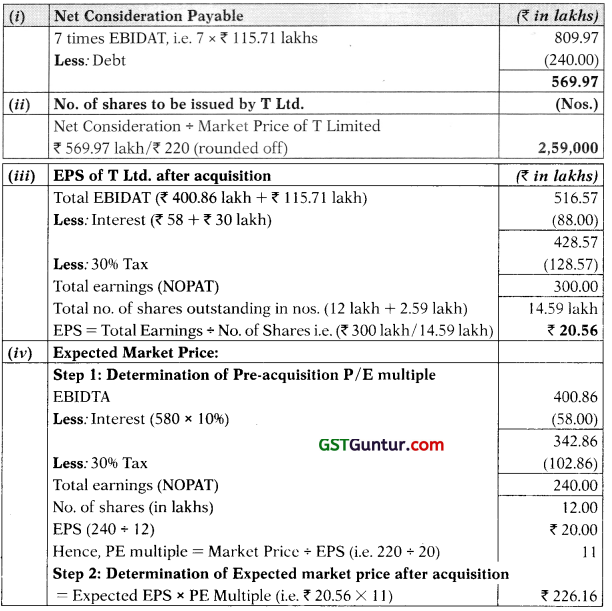
As per E Ltd’s Plan
|
(₹ in lakhs) |
| (i) Net Consideration Payable |
|
| 6 lakh shares × ₹ 110 |
660 |
| (ii) No. of shares to be issued by T Ltd. |
|
| ₹ 660 lakhs ÷ ₹ 220 |
3 lakh |
| (iii) EPS of T Ltd. after Acquisition |
|
| NPAT (as per earlier calculations) |
300.00 |
| Total no. of shares outstanding (12 lakhs – 3 lakhs) |
1 5 lakh |
| Earnings per share (EPS) ₹ 300 lakh 15 lakh |
₹ 20.00 |
| (iv) Expected Market Price (₹ 20 × 11) |
220 |
Advantage of Acquisition T Ltd.
Since the two companies are in the same industry, the following advantage could accrue:
(i) Synergy, cost reduction and operating efficiency.
(ii) Better market share
(ii) Avoidance of competition

Question 9.
TK Ltd. and SK Ltd. are both in the same industry. The former is in negotiation for acquisition of the latter. Information about the two companies as per their latest financial statements are given below:
|
TK Ltd. |
SK Ltd. |
| ₹ 10 Equity shares outstanding |
24 Lakhs |
12 Lakhs |
| 10% Debentures (₹ Lakhs) |
1160 |
– |
| 12.5% Institutional loan (₹ Lakhs) |
– |
480 |
| Earnings before interest, depreciation and tax (EBIDAT) (₹ Lakhs) |
800.00 |
230.00 |
| Market Price/Share (₹) |
220.00 |
110.00 |
TK Ltd. plans to offer a price for SK Ltd. business, as a whole, which will be 7 times of EBIDAT as reduced by outstanding debt and to be discharged by own shares at market price.
SK Ltd. is planning to seek one share in TK Ltd. for every 2 shares in SK Ltd. based on the market price. Tax rate for the two companies may be assumed as 30%.
Calculate and show the following under both alternatives- TK Ltd.’s offer and SK Ltd.’s plan:
(i) Net consideration payable.
(ii) No. of shares to be issued by TK Ltd.
(iii) EPS of TK Ltd. after acquisition.
(iv) Expected market price per share of TK Ltd. after acquisition.
(v) State briefly the advantages to TK Ltd. from the acquisition.
Calculate may be rounded off to two decimals points. [Nov. 2018 New Syllabus] [12 Marks]
Answer:
As per TK Ltd’s Offer
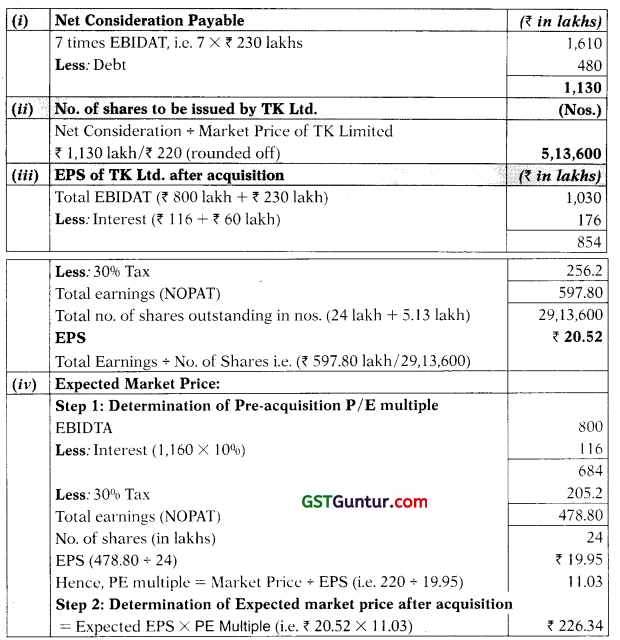
As per SK Ltd.’s Plan
|
(₹ in lakhs) |
| (i) Net Consideration Payable |
|
| 12 lakhs shares × ₹ 110 |
1,320 |
| (ii) No. of shares to be issued by TK Ltd. |
|
| ₹ 1,320 lakhs + ₹ 220 |
6 lakh |
| (iii) EPS of TK Ltd. after Acquisition |
|
| NOPAT (as per earlier calculations) |
597.80 |
| Total no. of shares outstanding (24 lakhs – 6 lakhs) |
30 lakh |
| Earnings Per share (EPS) ₹ 597.8 lakh 30 lakh |
₹ 19.93 |
| (iv) Expected Market Price (₹ 19.93 × 11) |
₹ 219.23 |
Advantage of Acquisition TK Ltd
Since the two companies are in the same industry, the following advantage could accrue.
(i) Synergy, cost reduction and operating efficiency.
(ii) Better market share.
(iii) Avoidance of competition.

Question 10
LMN Ltd. is considering merger with XYZ Ltd. LMN Ltd’s shares are currently traded at ₹ 30.00 per share. It has 3,00,000 shares outstanding. Its earnings after taxes (EAT) amount to ₹ 6,00,000. XYZ Ltd. has 1,60,000 shares outstanding and its current market price is ? 15.00 per share and its earnings after taxes (EAT) amount to ₹ 1,60,000. The merger is decided to be effected by means of a stock swap (exchange). XYZ Ltd. has agreed to a proposal by which LMN Ltd. will offer the current market value of XYZ Ltd’s shares.
Find out:
(i) The pre-merger earning per share (EPS) and price/earnings (P/E) ratios of both the companies.
(ii) If XYZ Ltd’s P/E Ratio is 9.6, what is its current Market Price? What is the Exchange Ratio? What will LMN Ltd.’s post-merger EPS be?
(iii) What should be the exchange ratio; if LMN Ltd.’s pre-merger and post-merger EPS are to be the same? [May 2012] [8 Marks]
Answer:
(i) Determination of Pre-merger EPS and P/E ratios:
| Particulars |
LMN Ltd.
(Acquirer) |
XYZ Ltd.
(Target) |
| Earnings after taxes |
6,00,000 |
1,60,000 |
| Number of shares outstanding |
3,00,000 |
1,60,000 |
| (Earnings per share) EPS (Rs. per share) |
2 |
1 |
| Market Price per share |
30 |
15 |
| P/E Ratio (times) |
15 |
15 |
(ii) Current Market Price of XYZ Ltd. if P/E ratio is 9.6
Current Market Price of XYZ = P/E Ratio × EPS = ₹ 1 × 9.6 = ₹ 9.60
Exchange ratio = \(\frac{\text { Market Price of Target Co. }(X Y Z \text { Lld. })}{\text { Market Price of Acquirer Co. }(L M N \text { Lid. })}\) = \(\frac{9.6}{30}\) = 32
Shares to be issued = 1,60,000 × 0.32 = 51,200 Shares
Post-merger EPS of LMN Ltd. = \(\frac{6,00,000+1,60,000}{3,00,000+51,200}\) = \(\frac{7,60,000}{3,51,200}\) = ₹ 2.16
(iii) Desired Exchange Ratio:
Exchange ratio = \(=\frac{\text { EPS of Target } C o .(X Y Z \text { Ltd.) }}{\text { EPS of Acquirer Co.(LMN Ltd.) }}\) = \(\frac{1}{2}\) = 0.5
Shares to be issued = 1,60,000 × 0.5 = 80,000 Shares
Post-merger EPS of LMN Ltd. = \(\frac{6,00,000+1,60,000}{3,00,000+80,000}\) = \(\frac{7,60,000}{3,80,200}\) = ₹ 2
Verification:
Before Merger = ₹ 1
Equivalent post-merger = ₹ 2 × 0.5 (exchange Ratio) = ₹ 1
Alternative Method of computation:
| Total number of shares in post merged company |
= \(\frac{\text { Post-merger earnings }}{\text { pre-merger EPS of LMN Ltd. }}\) = \( \frac{7,60,000}{2} \) = 3,80,000 shares |
| Number of shares required to be issued to XYZ Ltd. |
= 3,80,000 – 3,00,000 = 80,000 shares |
| Therefore, the exchange ratio (ER) should be |
= 80,000 : 1,60,000 = \(\frac{80,000}{1,60,000}\) = 0.50 |

Question 11.
XYZ Ltd. wants to purchase ABC Ltd. by exchanging 0.7 of its share for each share of ABC Ltd., Relevant financial data are as follows:
|
XYZ Ltd. |
ABC Ltd. |
| Equity shares outstanding (in numbers) |
10,00,000 |
4,00,000 |
| EPS (₹) |
40 |
28 |
| Market price per share (₹) |
253 |
160 |
(i) Illustrate the impact of merger on EPS of both the companies.
(ii) The management of ABC Ltd. has quoted a share exchange ratio of 1:1 for the merger. Assuming that P/E ratio of XYZ Ltd. will remain unchanged after the merger, what will be the gain from merger for ABC Ltd.?
(iii) What will be the gain/loss to shareholders of XYZ Ltd.?
(iv) Determine the maximum exchange ratio acceptable to shareholders of XYZ Ltd. [Nov. 2015] [10 Marks]
Answer:
Calculation of Earnings and P/E Ratio:
|
Earnings (EPS × No. of Shares) |
P/E Ratio(MPS + EPS) |
| XYZ Ltd. |
10,00,000 × 40 = ₹ 400 Lakhs |
Rs. 250 ÷ 40 = 6.25 |
| ABC Ltd. |
4,00,000 × 28 = ₹ 112 Lakhs |
Rs. 160 ÷ 28 = 5.71 |
Calculation of EPS after merger:
Share to be issued by XYZ to ABC = 4,00,000 × 1.7 = 2,80,000 shares
EPS = \(\frac{\text { Rs. } 400 \text { Lakhs }+ \text { Rs. } 112 \text { Lakhs }}{10 \text { Lakhs + 2.8 Lakhs Shares }}\) = \(\frac{\text { Rs. } 512 \text { Lakhs }}{12.8 \text { Lakh Shares }}\) = ₹ 40
(i) Merger impact of EPS with Exchange Ratio 0.7
|
EPS (Existing) |
EPS (After Merger) |
Change in EPS |
| XYZ Ltd. |
₹40 |
₹40 |
No Change |
| ABC Ltd. |
₹28 |
₹4 × 0.7 = ₹ 28 |
No Change |
(ii) Gain from Merger if Exchange Ratio is 1:1
Share to be issued by XYZ to ABC = 4,00,000 × 1 = 4,00,000 shares
EPS = \(=\frac{\text { Rs. } 400 \text { Lakhs }+ \text { Rs. } 112 \text { Lakhs }}{10 \text { Lakhs }+4 \text { Lakhs Shares }}\) = \(\frac{\text { Rs. } 512 \text { Lakhs }}{14 \text { Lakh Shares }}\) = ₹ 36.57
Market Price of Share = ₹ 36.57 × 6.25 = ₹ 228.56
Market Price (Before Merger of ABC) = ₹ 160
Gain from Merger = ₹ 68.56
(iii) Gain/Loss from the Merger to the shareholders of XYZ Ltd.
Market Price of Share = ₹ 228.56
Market Price (Before Merger of ABC) = ₹ 250
Loss from Merger (per share) = ₹ 21.44
(iv) Maximum Exchange Ratio acceptable to XYZ Ltd. Shareholders
|
₹ in Lakhs |
| Market Value of Merged Entity (₹ 228.57 × 14,00,000) |
3,199.98 |
| Less: Value acceptable to shareholders of XYZ Ltd. |
2,500.00 |
| Value of Merged Entity available to shareholders of ABC Ltd. |
699.98 |
| Market Price per share |
250.00 |
| No. of shares to be issued to shareholders of ABC Ltd. (Lakhs) |
2.80 |
Thus, maximum ratio of issue shall be 2.80:4.00 or 0.70 share of XYZ Ltd. for one share of ABC Ltd.

Question 12.
A Lid., a listed company, is considering merger of B Ltd. which is also a listed company, with itself by means of a stock swap (exchange). B Ltd. has agreed to a plan under which A Ltd. will offer the current market value of B Ltd’s shares.
Additional Information :
| Particulars |
A Ltd. |
B Ltd. |
| Earnings after tax (Rs.) |
10,00,000 |
2,50,000 |
| Number of shares outstanding |
4,00,000 |
2,00,000 |
| Current market price (Rs.) per share |
50 |
20 |
On the basis of above information, you required to calculate the following:
(i) What is the pre-merger Earnings Per Share (EPS) and P/E ratios of both the companies?
(ii) If B Ltd.’s P/E is 10, what will be its current market price per share ? What will be the exchange ratio on the basis of such market price? What will be the A Ltd.’s post-merger EPS?
(iii) What must be the exchange ratio if A Ltd.’s Pre-merger and Post-merger EPS to be the same? [Nov. 2019, Modified] [8 Marks]
Answer:
(i) Calculation of Pre-merger EPS & P/E Ratio
|
EPS = Earnings ÷ No. of Shares |
P/E Ratio = MPS ÷ EPS |
| A Ltd. |
\(\frac{\mathrm{Rs} .10,00,000}{4,00,000}\) = Rs. 2.50 |
Rs. 50 ÷ 2,5 = 20 Times |
| B Ltd. |
\(\frac{\text { Rs. } 2,50,000}{2,00,000}\) = Rs. 1.25 |
Rs. 20 ÷ 1.25 = 16 Times |
(ii) Current Market Price of B Ltd. if P/E is 10
EPS (B Ltd.) = Rs. 1.25
P/E Ratio = 10 times
Market Price = 1.25 × 10 = Rs. 12.50
Exchange Ratio (ER) on the basis of Revised Market Price
Exchange Ratio = \(\frac{\text { Market Price of B Ltd. }}{\text { Market Price of A Ltd. }}\) = \(\frac{12.50}{50}\) = 0.25
Share to be issued by A Ltd. to B Ltd. = 2,00,000 × 0.25 = 50,000 shares.
Post Merger EPS of A Ltd.
EPS (A Ltd.) = \(\frac{10,00,000+2,50,000}{4,00,000+50,000}\) = Rs. 2.78
(iii) Required Exchange Ratio to maintain EPS of A Ltd.
The pre-merger and post-merger EPS would be the same if Exchange Ratio is based on EPS. It may be determined as under:
Exchange Ratio = \(\frac{\text { EPS of B Ltd. (Target Company) }}{\text { EPS of A Ltd. (Acquiring Company) }}\) = \(\frac{1.25}{2.50}\) = 0.5
Verification:
EPS (After Acquisition) = \(\frac{10,00,000+2,50,000}{4,00,000+(2,00,000 \times 0.5)}\) = Rs. 2.50
Question 13.
A Ltd. wants to acquire T Ltd. and has offered a swap ratio of 1:2 (0.5 shares for every one share of T Ltd.). Following information is provided:
|
A Ltd. |
T Ltd. |
| Profit after tax (₹) |
18,00,000 |
3,60,000 |
| Equity shares outstanding (Nos.) . |
6,00,000 |
1,80,000 |
| EPS (₹) |
3 |
2 |
| PE Ratio |
10 times |
7 times |
| Market price per share (₹) |
30 |
14 |
(i) The number of equity shares to be issued by A Ltd. for acquisition of T Ltd.
(ii) What is the EPS of A Ltd. after the acquisition?
(iii) Determine the equivalent earnings per share of T Ltd.
(iv) What is the expected market price per share of A Ltd. after the acquisition, assuming its PE multiple remains unchanged?
(v) Determine the market value of the merged firm. [Nov. 2007] [10 Marks]
Answer:
(i) The number of shares to be issued by A Ltd.:
The Exchange ratio is 0.5
So, new Shares = 1,80,000 × 0.5 = 90,000 shares.
(ii) EPS of A Ltd. after acquisition:
Total Earnings (₹ 18,00,000 + ₹ 3,60,000) = ₹ 21,60,000
No. of Shares (6,00,000 + 90,000) = 6,90,000
EPS (₹ 21,60,000/6,90,000) = ₹ 3.13
(iii) Equivalent EPS of T Ltd.:
No. of new Shares = 0.5
EPS = ₹ 3.13
Equivalent EPS (₹ 3.13 × 0.5) = ₹ 1.57
(iv) New Market Price of A Ltd. (P/E remaining unchanged):
Present P/E Ratio of A Ltd. = 10 times
Expected EPS after merger = ₹ 3.13
Expected Market Price (₹ 3.13 × 10) = ₹ 31.30
Market Value of merged firm:
Total number of Shares = 6,90,000
Expected Market Price = ₹ 31.30
Total’ alue (6,90,000 × 31.30) = ₹ 2,15,97,000

Question 14.
ABC Ltd. is intending to acquire XYZ Ltd. by merger and the following information is available in respect of the companies:
|
ABC Ltd. |
XYZ Ltd. |
| Number of equity shares |
10,00,000 |
6,00,000 |
| Earnings after tax (₹) |
50,00,000 |
18,00,000 |
| Market value per share (₹) |
42 |
28 |
Required:
(i) What is the present EPS of both the companies?
(ii) If the proposed merger takes place, what would be the new earning per share for ABC Ltd.? Assume that the merger takes place by exchange of equity shares and the exchange ratio is based on the current market ‘ price.
(iii) What should be exchange ratio, if XYZ Ltd. wants to ensure the earnings to members are as before the merger takes place? [May 2004] [8 Marks]
Answer:
(i) Earnings per share = Earnings after tax/No. of equity shares
ABC Ltd. = ₹ 50,00,000/10,00,000 = ₹ 5
XYZ Ltd. = ₹ 18,00,000/6,00,000 = ₹ 3
(it) Number of Shares XYZ limited’s shareholders will get in ABC Ltd. based on market value per share = ₹ 28/42 × 6,00,000 = 4,00,000 shares
Total number of equity shares of ABC Ltd. after merger = 10,00,000 + 4,00,000 = 14,00,000 shares.
Earnings per share after merger = (₹ 50,00,000 + 18,00,000)/14,00,000 = ₹ 4.86
(iii) Calculation of exchange ratio to ensure shareholders of XYZ Ltd. to earn the same as was before merger:
Shares to be exchanged based on EPS = (₹ 3/₹ 5) × 6,00,000 = 3,60,000 shares
EPS after merger = (₹ 50,00,000 + 18,00,000)/13,60,000 = ₹ 5
Total earnings in ABC Ltd. available to shareholders of XYZ Ltd. = 3,60,000 × ₹5 = ₹ 18,00,000.
Thus, to ensure that Earning to members are same as before, the ratio of exchange should be 0.6 share for 1 share.
Question 15.
XYZ Ltd. is considering merger with ABC Ltd. XYZ Ltd.’s shares are currently traded at ₹ 25. It has 2,00,000 shares outstanding and its earnings after taxes (EAT) amount to ₹ 4,00,000. ABC Ltd. has 1,00,000 shares outstanding: its current market price is ₹ 12.50 and its EAT is ₹ 1,00,000. The merger will be effected by means of a stock swap (exchange). ABC Ltd. has agreed to a plan under which XYZ Ltd. will offer the current market value of ABC Ltd.’s shares.
(i) What is the pre-merger earnings per share (EPS) and P/E ratios of both the companies?
(ii) If ABC Ltd.’s P/E ratio is 8, what is its current market price? What is the exchange ratio? What will XYZ Ltd.’s post merger EPS be?
(iii) What must the exchange ratio be for XYZ Ltd.’s pre-merger and postmerger EPS to be the same? [May 2005] [8 Marks]
Answer:
(i) Determination of Pre-merger EPS and P/E ratios:
| Particulars |
XYZ Ltd. (Acquirer) |
ABC Ltd.
(Target) |
Earnings After taxes (₹)
Number of shares outstanding |
4,00,000
2,00,000 |
1,00,000
1,00,000 |
| (Earnings per share) EPS (₹ per share) share) |
2 |
1 |
| Market Price per share (₹) |
25 |
12.5 |
| P/E Ratio (times) |
12.5 |
12.5 |
(ii) Current Market Price of ABC Ltd. if P/E ratio is 8
Current Market Price of ABC = P/E Ratio × EPS = 8 × ₹ 1 = ₹ 8
Exchange ratio = \(\frac{\text { Market Price of Target Co. }(A B C \text { Ltd. })}{\text { Market Price of Acquirer }{Co}(X Y Z ~ L t d .)}\) = \(\frac{8}{25}\) = 32
Shares to be issued = 1,00,000 × 0.32 = 32,000 Shares
Post-merger EPS of XYZ Ltd. = \(\frac{4,00,000+1,00,000}{2,00,000+32,000}=\frac{5,00,000}{2,32,000}\) = ₹ 2.16
(iii) Desired Exchange Ratio:
Exchange ratio = \(\frac{\text { EPS of Target Co. (ABC Ltd.) }}{\text { EPS of Acquirer Co. (XYZ Ltd.) }}\) = \(\frac{1}{2}\) = 0.5
Shares to be issued = 1,00,000 × 0.5 = 50,000 Shares
Post-merger EPS of XYZ Ltd. = \(\frac{4,00,000+1,00,000}{2,00,000+50,000}=\frac{5,00,000}{2,50,000}\) = ₹ 2
Verification:
Before Merger = ₹ 1
Equivalent post-merger = ₹ 2 × 0.5 (exchange Ratio) = ₹ 1
Alternative Method of computation:
| Total number of shares in post-merged company |
= \(\frac{\text { Post }- \text { merger earnings }}{\text { pre }- \text { merger EPS of XYZ Ltd. }}\)
= \(\frac{5,00,000}{2}\) = 2,50,000 Shares |
| Number of shares required to be issued to ABC Ltd. |
= 2,50,000 – 2,00,000 = 50,000 Shares |
| Therefore, the exchange ratio (ER) should be |
= 50,000 : 1,00,000 = \( \frac{50,000}{1,00,000} \) = 0.50 |

Question 16.
M Co. Ltd., is studying the possible acquisition of N Co. Ltd., by way of merger. The following data are available in respect of the companies:
| Particulars |
M Co. Ltd. |
N Co. Ltd. |
| Earnings after tax (₹) |
80,00,000 |
24,00,000 |
| No. of equity shares |
16,00,000 |
4,00,000 |
| Market value per share (₹) |
200 |
160 |
(i) If the merger goes through by exchange of equity and the exchange ratio is based on the current market price, what is the new earning per share for M Co. Ltd.?
(ii) N Co. Ltd. wants to be sure that the earnings available to its shareholders will not be diminished by the merger. What should be the exchange ratio in that case? [Nov. 2003] [8 Marks]
Answer:
(i) Determination of new EPS of M Ltd. (After Merger):
| Exchange Ratio |
= \(\frac{\text { Market Value of } N L t d}{\text { Market Value of } M L t d .}\) = \(\frac{160}{200\) = 0.
[0.8 shares of M Ltd. for every 1 share of N Ltd.] |
| No. of shares to be issued |
= 4,00,000 × 0.8 = 3,20,000 Shares |
| Total Shares of M Limited (after merger) |
= 16,00,000 + 3,20,000 = 19,20,000 Shares |
| Total Profits of M Ltd. (After Merger) |
₹ 80,00,000 + ₹ 24,00,000 = ₹ 104,00,000 |
| EPS of M Ltd. (After Merger) |
= \(\frac{R s \cdot 104,00,000}{19,20,000 \text { Shares }}\) = ₹ 5.416 |
(ii) Exchange Ratio so that shareholder of N Ltd. would not be at a Loss:
The shareholders of N Limited would not be at loss if the exchange ratio is based on EPS.
|
M Ltd. |
N Ltd. |
| EPS before Merger |
= \(\frac{R s \cdot 80,00,000}{16,00,000 \text { Shares }}\) = ₹ 5.00 |
= \(\frac{R s .24,00,000}{4,00,000 \text { Shares }}\) = ₹ 60 |
Exchange Ratio (with EPS as base) = \(\frac{E P S \text { of } N L t d .(\text { Target Co.) }}{E P S \text { of } M L t d .(\text { Acquirer Co.) }}\)
= \(\frac{R s .6}{R s .5}\) = 1.2
It means 1.2 shares of M Ltd. for every 1 share of N Ltd.
Shares to be issued to N Ltd. = 4,00,000 Shares × 1.2 = 4,80,000 Shares
Total number of Shares = 16,00,000 + 4,80,000 = 20,80,000 Shares
EPS of M Ltd. (after merger) = \(\frac{\text { Rs. } 80,00,000+R s .24,00,000}{\text { Rs.20,80,000 }}\) = ₹ 500
Verification that the shareholders of target company are not at loss:
The EPS available to Shareholders of N Ltd.:
Before Merger = 4,00,000 shares × ₹ 6 = ₹ 24,00,000
After Merger = Shares issued to N × Post merger EPS
= 4,80,000 × 5 = ₹ 24,00,000
Therefore, the exchange ratio on the basis of EPS is recommended.
Question 17.
The following information is provided related to the acquiring Mark Limited and the target Mask Limited:
|
Mark Limited |
Mask Limited |
| Earnings after tax (₹) |
2,000 lakhs |
400 lakhs |
| Number of shares outstanding |
200 lakhs |
100 lakhs |
| P/E ratio (times) |
10 |
5 |
Required:
(i) What is the Swap Ratio based on current market prices?
(ii) What is the EPS of Mark Limited after acquisition?
(iii) What is the expected market price per share of Mark Limited after acquisition, assuming P/E ratio of Mark Limited remains unchanged?
(iv) Determine the market value of the merged firm.
(v) Calculate gain/loss for shareholders of the two independent companies after acquisition. [Nov. 2004] [8 Marks]
Answer:
(i) Determination of SWAP Ratio based on Current Market Price:
Determination of Current Market Price Per Share:
| Particulars |
Mark Ltd. (Acquirer) |
Mask Ltd. (Target) |
Earnings After taxes (₹)
Number of shares outstanding |
2,000 Lakhs
200 Lakhs |
400 Lakhs
100 Lakhs |
| EPS (Earnings per share) |
₹ 10 |
₹ 4 |
| P/E Ratio (times) |
10 |
5 |
| Market Price per share |
₹ 100 |
₹ 20 |
Determination of SWAP Ratio:
Exchange Ratio = \(\frac{\text { Market Value of Mask Ltd. }(\text { Target Co. })}{\text { Market Value of Mark Ltd. }(\text { Acquiring Co. })}\) = \(\frac{20}{100}\) = 0.2
[0.2 share of Mark Ltd. for every 1 share of Mask Ltd.]
(ii) Determination of EPS of Mark Limited after acquisition:
| Exchange Ratio |
0.2 |
| No. of shares to be issued |
= 100 Lakhs × 0.2 = 20 Lakhs Shares |
| Total Shares of Mark Limited (after merger) |
= 200 Lakhs + 20 Lakhs = 220 Shares |
| Total Profits of Mark Ltd. (After Merger) |
= ₹ 2,000 + ₹ 400 = ₹ 2,400 Lakhs |
| EPS of Mark Ltd. (After Merger) |
= \(\frac{\text { Rs. 2,400 Lakhs }}{220 \text { Lakhs Shares }}\) = ₹ 10.91 |
(iii) Determination of Expected Market Price of Mark Limited after acquisi-tion:
P/E ratio of new firm (expected to remain same) = 10 times
New market price (10 × ₹ 10.91) = ₹ 109.10
(iv) Market value of merged firm
= ₹ 109.10 market price × 220 lakhs shares = ₹ 240.02 crores
(v) Gain from the merger
Post merger market value of the merged firm = ₹ 240.02 crores
Less: Pre-merger market value
Mark Ltd. 200 Lakhs × ₹ 100 = 200 crores
Mask Ltd. 100 Lakhs × ₹ 20 = 20 crores = ₹ 220.00 crores
Gain from merger = ₹ 20.02 crores
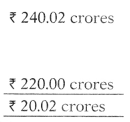
Appropriation of gains from the merger among shareholders:
|
Mark Ltd. |
Mask Ltd. |
| Post-merger value
Less: Pre-merger market value |
218.20 crores
200.00 crores |
21.82 crores
20.00 crores |
| Gain to Shareholders |
18.20 crores |
1.82 crores |

Question 18.
Following information is provided relating to the acquiring company Mani Ltd. and the target company Ratnam Ltd:
|
Mani Ltd. |
Ratnam Ltd. |
| Earnings after tax (₹ in lakhs) |
2,000 |
4,000 |
| Number of shares outstanding (lakhs) |
200 |
1,000 |
| P/E ratio (No. of times) |
10 |
5 |
Required:
(i) What is the swap ratio based on current market prices?
(ii) What is the EPS of Mani Ltd. after the acquisition?
(iii) What is the expected market price per share of Mani Ltd. after the acquisition, assuming its P/E ratio is adversely affected by 10%? [June 2009] [10 Marks]
Answer:
(i) Determination of SWAP Ratio based on Current Market Price:
Determination of EPS and Current Market Price before acquisition:
| Particulars |
Mani Ltd. (Acquirer) |
Ratnam Ltd. (Target) |
Earnings After taxes (₹)
Number of shares outstanding |
2,000 Lakhs
200 Lakhs |
4,0000 Lakhs
1,0000 Lakhs |
| P/E Ratio (times) |
10 |
5 |
| EPS (Earnings per share) ₹ |
10 |
4 |
| Market Price per share ₹ |
100 |
20 |
Determination of SWAP Ratio:
Exchange Ratio = \(\frac{\text { Market Value of Ratnam Ltd. (Target } C o .)}{\text { Market Value of Mani Ltd. }(\text { Acquiring Co.) }}\) = \(\frac{20}{100}\) = 0.2
[0.2 share of Mani Ltd. for every 1 share of Ratnam Ltd.]
(ii) Determination of EPS of Mani Limited after acquisition:
| Exchange Ratio |
0.2 |
| No. of shares to be issued |
= 1,000 Lakhs × 0.2 = 200 Lakhs Shares |
| Total Shares of Mani Limited (after merger) |
= 200 Lakhs + 200 Lakhs = 400 Shares |
| Total Profits of Mani Ltd. (After Merger) |
= ₹ 2,000 + ₹ 4,000 = ₹ 6,000 Lakhs |
| EPS of Mani Ltd. (After Merger) |
= \(\frac{\text { Rs.6,000 Lakhs }}{400 \text { Lakhs Shares }}\) = ₹ 15 |
(iii) Determination of Expected Market Price of Mani Limited after acquisition:
EPS after acquisition ₹ 15
P/E ratio (after acquisition) = 10 × 0.9 = 9 times
New market price (9 × ₹ 15) = ₹ 135
(iv) Market value of merged company:
= ₹ 135 × 400 Lakh Shares = ₹ 54,000 Lakhs or ₹ 540 Crores
(v) Gain from the merger
|
Mani Ltd. |
Ratnam Ltd. |
| Total value before acquisition Less: Value after acquisition |
200 crores
270 crores |
200 crores
270 crores |
| Total Gain |
70 crores |
70 crores |
| No. of shares (pre-merger) (Lakhs) |
200 |
1,000 |
| Gain per share (₹) |
35 |
7 |

Question 19.
ABC Ltd. is a company operating in the software industry. It is considering the acquisition of XYZ Ltd. which is also into software industry. The following information are available for the companies:
|
ABC Ltd, |
XYZ Ltd, |
| Earnings after tax (Rs.) |
9,00,000 |
2,40,000 |
| Number of equity shares |
1,50,000 |
60,000 |
| P/E ratio (no. of times) |
14 |
10 |
ABC Ltd. is planning to offer a premium of 25% over the market price of XYZ Ltd. Required:
(i) What is the swap ratio based on current market price ?
(ii) Find the number of shares to be issued by ABC Ltd. to the shareholders of XYZ Ltd.
(iii) Compute the new EPS of ABC Ltd. after merger and comment on the impact of merger.
(iv) Determine the market price of the share when P/E ratio remains unchanged.
(v) Compute the market price when P/E declines to 12 and comment on the results. Figures are to be rounded off to 2 decimals. [Nov. 2019 Old Syllabus] [10 Marks]
Answer:
(i) Determination of SWAP Ratio based on Current Market Price:
Determination of EPS and Current Market Price before acquisition:
| c |
ABC Ltd. (Acquirer) |
XYZ Ltd. (Target) |
| Earnings after tax (Rs.) |
9,00,000 |
2,40,000 |
| Number of shares outstanding |
1,50,000 |
60,000 |
| P/E Ratio (times) |
14 |
10 |
| EPS (Earnings per share) Rs. |
6 |
4 |
| Market Price per share Rs. |
84 |
40 |
Determination of SWAP Ratio Based on Current Market Price:
The Premium offered by ABC Limited has not been considered as SWAP ratio is to be calculated on the basis of Current Market Price.
Exchange Ratio = \(\frac{\text { Market Value of XYZ Ltd. (T arg et Co.) }}{\text { Market Value of ABC Ltd. (Acquring Co.) }}\) = \(\frac{0 \times 1.25}{84}\) = 0.6
[0.6 share of ABC Ltd. for every 1 share of XYZ Ltd.]
(ii) Determination of No. of Shares:
Exchange Ratio = 0.6 (as calculated above)
Agreed Exchange Ratio = 0.60
No. of Shares of XYZ Ltd. = 60,000
Share to be issued by ABC Ltd. = 60,000 × 0.6 = 36,000 shares.
(iii) Determination of EPS of ABC Limited after acquisition:
| No. of shares issued |
= 36,000 Shares |
| Total Shares of ABC Limited (after merger) |
= 1,50,000 + 36,000 = 1,86,000 Shares |
| Total Profits of ABC Ltd. (After Merger) |
= Rs.9,00,000 + 2,40,000 = 11,40,000 |
| EPS of ABC Ltd. (After Merger) |
= \(\frac{\text { Rs. } 11,40,000}{1,86,000 \text { Shares }}\) = Rs. 6.13 |
(iv) Determination of Expected Market Price of ABC Limited after acquisition if P/E ratio remains unchanged:
EPS after Acquisition = Rs. 6.13
New Market Price (14 × Rs. 6.13) = Rs. 85.82
(v) Determination of Expected Market Price of ABC Limited after acquisition if P/E ratio declines to 12:
EPS after acquisition = Rs. 6.13
Declined P/E ratio (after acquisition) = 12 times
Resultant New market price (12 × Rs. 6.13) = Rs. 73.56

Question 20.
P Ltd. is considering takeover of R Ltd. by the exchange of four new shares in P Ltd. for every five shares in R Ltd. The relevant financial details of the two companies prior to merger announcement are as follows:
|
P Ltd. |
R Ltd. |
| Profit before Tax (₹ Crore) |
15 |
13.50 |
| No. of Shares (Crore) |
25 |
15 |
| P/E Ratio |
12 |
9 |
| Corporate Tax Rate 30% |
|
|
You are required to determine:
(i) Market value of both the company.
(ii) Value of original shareholders.
(iii) Price per share after merger.
(iv) Effect on share price of both the company if the Directors of P Ltd. expect their own pre-merger P/E ratio to be applied to the combined earnings. [Nov. 2010 (Modified)] [10 Marks]
Answer:
|
P Ltd. |
R Ltd. |
| Profit before Tax (₹ in crore) |
15 |
13.50 |
| Tax 30% (₹ in crore) |
4.50 |
4.05 |
| Profit after Tax (₹ in crore) |
10.50 |
9.45 |
| Earning per Share (₹) |
\(\frac{10.50}{25}\) = ₹ 0.42 |
\(\frac{9.45}{15}\)= ₹ 0.63 |
| Price of Share before Merger |
₹ 0.42 × 12 |
0.63 × ₹ 9 |
| (EPS X P/E Ratio) |
= ₹ 5.04 |
= ₹ 5.67 |
(i) Market Value of company
P Ltd. = ₹ 5.04 × 25 Crore = ₹ 126 crore
R Ltd. = ₹ 5.67 × 15 Crore = ₹ 85.05 crore
Combined = ₹ 126 + ₹ 85.05 = ₹ 211.05 Crores
After Merger
|
P Ltd. |
R Ltd. |
| No. of Shares |
25 crores |
15 × \(\frac{4}{5}\) = 12 crores |
| Combined |
37 crores |
| % of Combined Equity Owned |
\(\frac{25}{37}\) × 100 = 67.57% |
\(\frac{12}{37}\) × 100 = 32.43% |
(ii) Value of Original Shareholders
| P Ltd. |
R Ltd. |
| ₹ 211.05 crore × 67.57% = ₹ 142.61 |
₹ 211.05 crore × 32.43% = ₹ 68.44 |
(iii) Price per Share after Merger
EPS = ₹ \(\frac{₹ 19.95 \text { crore }}{37 \text { crore }}\) = ₹ 0.539 per share
P/E Ratio = 12
Market Value per Share = ₹ 0.539 × 12 = ₹ 6.47
Total Market Value = ₹ 6.47 × 37 crore = ₹ 239.39 crore
Price of Share = \(\frac{\text { Market Value }}{\text { Number of Shares }}\) = \(\frac{239.39 \text { crore }}{37 \text { crore }}\) = ₹ 6.47
(iv) Effect on Share Price
| MPS before merger |
₹ 5.04 |
₹ 5.67 |
MPS after merger
(Equivalent for R Ltd.) |
₹ 6.47 |
6.47 × \(\frac{4}{5}\) = ₹ 5.18 |
| Gain (Loss) per share |
₹ 1.43 (Gain) |
₹ 0.49 (Loss) |
| Change in share price |
= \(\frac{1.43}{5.04}\) × 100
= 0.284
= 28.4%Rise in share price |
= \(\frac{-0.49}{5.67}\) × 100
= – 0.0864
(- ve) 8.64%
Decrease in share price |

Question 21.
Reliable Industries Ltd. (RIL) is considering a takeover of Sunflower Industries Ltd. (SIL). The particulars of 2 companies are given below:
| Particulars |
Reliable Industries Ltd. |
Sunflower Industries Ltd. |
| Earnings After Tax (EAT) |
₹ 20,00,000 |
₹ 10,00,000 |
| Equity shares Outstanding |
10,00,000 |
10,00,000 |
| Earnings per share (EPS) |
2 |
1 |
| P/E Ratio (Times) |
10 |
5 |
Required:
(i) What is the market value of each Company before merger?
(ii) Assume that the management of RIL estimates that the shareholders of SIL will accept an offer of one share of RIL for four shares of SIL.
If there are no synergic effects, what is the market value of the Postmerger RIL? What is the new price per share? Are the shareholders of RIL better or worse off than they were before the merger?
(iii) Due to synergic effects, the management of RIL estimates that the earnings will increase by 20%. What are the new post-merger EPS and Price per share? Will the shareholders be better off or worse off than before the merger? [May 2006] [8 Marks]
Answer:
(i) Market value of Companies before Merger
| Particulars |
RIL |
SIL |
| EPS |
₹ 2 |
₹ 1 |
| P/E Ratio |
10 |
5 |
| Market Price Per Share |
₹ 20 |
₹ 5 |
| Equity Shares |
10,00,000 |
10,00,000 |
| Total Market Value |
2,00,00,000 |
50,00,000 |
(ii) Post-Merger Effects on RIL
|
₹ |
| Post-merger earnings |
30,00,000 |
| Exchange Ratio (1:4) |
|
| No. of equity shares outstanding (10,00,000 + 2,50,000) |
12,50,000 |
| EPS : 30,00,000/12,50,000 |
2.4 |
| P/E Ratio |
10 |
| Market Value (10 × 2.4) |
24 |
| Total Value (12,50,000 × 24) |
3,00,00,000 |
Gains from Merger:

Apportionment of Gains between the Shareholders:
| Particulars |
RIL (₹) |
SIL (₹) |
| Post Merger Market Value: |
10,00,000 × 24 = 2,40,00,000 |
2,50,000 × 24 = 60,00,000 |
| Less: Pre-Merger Market Value |
2,00,00,000 |
50,00,000 |
| Gains from Merger |
40,00,000 |
10,00,000 |
Thus, the shareholders of both the companies (RIL + SIL) are better off than before
(iii) Post-Merger Earnings:
| Increase in Earnings by 20% |
|
| New Earnings = ₹ 30,00,000 × (1 + 0.20) |
₹ 36,00,000 |
| No. of equity shares outstanding |
12,50,000 |
| EPS (₹ 36,00,000/12,50,000) |
₹ 2.88 |
| P/E Ratio |
10 |
| Market Price Per Share = ₹ 2.88 × 10 |
= ₹ 28.80 |
| Shareholders will be better-off than before the merger situation. |
|

Question 22.
The CEO of a company thinks that shareholders always look for EPS. Therefore he considers maximization of EPS as his company’s objective. His company’s current Net Profits are ₹ 80 lakhs and P/E multiple is 10.5. He wants to buy another firm which has current income of ₹ 15.75 lakhs & P/E multiple of 10.
What is the maximum exchange ratio which the CEO should offer so that he could keep EPS at the current level, given that the current market price of both the acquirer and the target company are ₹ 42 and ₹ 105 respectively₹
If the CEO borrows funds at 15% and buys out Target Company by paying cash, how much should he offer to maintain his EPS₹ Assume tax rate of 30%. [May 2016] [8 Marks]
Answer:
(i) Determination of Maximum Exchange Ratio
|
Acquirer Company |
Target Company |
| Net Profit |
₹ 80 Lakhs |
₹ 15.75 Lakhs |
| P/E multiple |
10.50 |
10.00 |
| Market Capitalisation |
₹ 840 Lakhs |
₹ 157.50 Lakhs |
| Market Price |
₹ 42 |
₹ 105 |
| No. of Shares |
20 Lakhs |
1.50 Lakhs |
| EPS |
₹ 4 |
₹ 10.50 |
Maximum Exchange ratio = \(\frac{\text { EPS of Target Co. }}{\text { EPS of of Acquirer Co. }}\) = \(\frac{10.5}{4}\) = 2.625
Thus, for every one share of Target Company 2.625 shares of Acquirer Company will be issued.
(ii) Determination of Maximum Exchange Ratio
Let x lakhs be the amount paid by ‘Acquirer Company’ to ‘target company’. Then, to maintain the same EPS (i.e. Rs. 4) the number of shares to be issued will be:
\(\frac{(80 \text { Lakhs }+15.75 \text { Lakhs })-0.70 \times 150 \times x}{20 \text { Lakhs }}\) = ₹ 4
\(\frac{95.75-0.105 x}{20}\) = ₹ 4
x = ₹ 150 Lakhs
Thus, ₹ 150 Lakhs shall be offered in cash to target company to maintain same EPS.
Question 23.
C Ltd. & D Ltd. are contemplating a merger deal in which C Ltd. will acquire D Ltd. the relevant information about the firms are given as follow:
|
C Ltd. |
D Ltd. |
| Total Earning (E) (in millions) |
₹ 96 |
₹ 30 |
| Number of outstanding shares (S) (in millions) |
20 |
14 |
| Earnings per share (EPS) (₹ ) |
4.8 |
2.143 |
| Price earnings ratio (P/E) |
8 |
7 |
| Market price per share (P) (₹) |
38.4 |
15 |
(i) What is the maximum exchange ratio acceptable to the shareholders of C Ltd., if the ratio of the combined firm is 7?
(ii) What is the minimum exchange ratio acceptable to the shareholder of D Ltd., if the P/E ratio of the combined firm is 9? [Nov. 2018 Old Syllabus] [12 Marks]
Answer:
(i) Maximum Exchange Ratio acceptable to the shareholders of C Limited
| Market Price of share of C Ltd. (₹ 4.8 × 8) |
₹ 38.40 |
| No. of Equity Shares |
20 Million |
| Market Capitalisation of C Ltd. (₹ 38.40 × 20 Million) |
₹ 768 Million |
| Combined Earnings (₹ 96 + ₹ 30 Million) |
₹ 126 Million |
| Combined Market Capitalisation (₹ 126 Million × 7) |
₹ 882 Million |
| Market Capitalisation of C Ltd. (₹ 38.40 × 20 Million) |
₹ 768 Million |
| Balance for D Ltd. |
₹ 114 Million |
Let D be the no. of equity shares to be issued to D Ltd. then,
D = \(\frac{₹ 114 \text { Million }}{\left[\frac{126 \text { Million }}{D+20}\right] \times 7}\)
Solving for D, we get
D = 2.96875 Million Shares
Exchange Ratio = \(\frac{2.96875}{14}\) = 0.212:1
(ii) Minimum Exchange Ratio: acceptable to the shareholders of D Ltd.
| Market Price of share of D Ltd. |
₹ 15.00 |
| No. of Equity Shares |
14 Million |
| Market Capitalisation of D Ltd. (₹ 15.00 × 14 Million) |
₹ 210 Million |
| Combined Earnings (₹ 96 + ₹ 30) Million |
₹ 126 Million |
| Combined Market Capitalisation (₹ 126 Million × 9) |
₹ 1,134 Million |
| Balance for C Ltd. |
₹ 924 Million |
Let D be the no. of equity shares to be issued to D Ltd. then,
D = \(\frac{\text { Rs. } 210 \text { Million }}{\left[\begin{array}{c}
126 \text { Million } \\
\text { D }+20
\end{array}\right] \times 9}\)
D = 4.54545 Million Shares
Exchange Ratio = \(\frac{4.54545}{14}\) = 0.325:1
Alternative Method of finding Minimum and Maximum Ratio
(i) Maximum Exchange Ratio from the point of the shareholders of C Ltd.
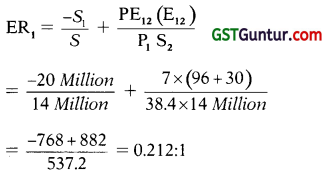
(ii) Minimum Exchange Ratio from the point of the shareholders of D Ltd.


Question 24.
The following information relating to the acquiring Company Abhiman Ltd. and the target Company Abhishek Ltd. are available. Both the Companies are promoted by Multinational Company, Trident Ltd. The promoter’s holding is 50% and 60% respectively in Abhiman Ltd. and Abhishek Ltd. :
|
Abhiman Ltd. |
Abhishek Ltd. |
| Share Capital (₹) |
200 lakh |
100 lakh |
| Free Reserves and Surplus (₹) |
800 lakh |
500 lakh |
| Paid up Value per share (₹) |
100 |
10 |
| Free float Market Capitalisation (₹) |
400 lakh |
128 lakh |
| P/E Ratio (times) |
10 |
4 |
Trident Ltd. is interested to do justice to the shareholders of both the Companies. For the swap ratio weights are assigned to different parameters by the Board of Directors as follows:
| Book Value |
25% |
| EPS (Earning per share |
50% |
| Market Price |
25% |
(a) What is the swap ratio based on above weights?
(b) What is the Book Value, EPS and expected Market price of Abhiman Ltd. after acquisition of Abhishek Ltd. (assuming P.E. ratio of Abhiman Ltd. remains unchanged and all assets and liabilities of Abhishek Ltd. are taken over at book value).
(c) Calculate:
(i) Promoter’s revised holding in the Abhiman Ltd.
(ii) Free float market capitalization
(iii) Also calculate No. of Shares, Earning per Share (EPS) and Book Value (B.V.), if after acquisition of Abhishek Ltd., Abhiman Ltd. decided to:
(1) Issue Bonus shares in the ratio of 1 : 2; and
(2) Split the stock (shares) as ₹ 5 each fully paid. [May 2009] [20 Marks]
Answer:
(a) Calculation of Book Value, Market Price and EPS
|
Abhiman Ltd. (Acquirer Co.) |
Abhishek Ltd. (Target Co.) |
| Share Capital |
200 Lakh |
100 Lakh |
| Free Reserves |
800 Lakh |
500 Lakh |
| Total |
1000 Lakh |
600 Lakh |
| No. of Shares |
2 Lakh |
10 Lakh |
| Book Value per share |
₹ 500 |
₹ 60 |
| Promoter’s holding |
50% |
60% |
| Non-promoter’s holding |
50% |
40% |
| Free Float Market Cap. i.e. Relating to Public’s holding |
400 Lakh |
128 Lakh |
| Hence Total market Cap. |
800 Lakh |
320 Lakh |
| No.of Shares |
2 Lakh |
10 Lakh |
| Market Price |
₹ 400 |
₹ 32 |
| P/E Ratio |
10 |
4 |
| EPS |
₹ 40 |
₹ 8 |
Calculation of weighted Swap Ratio

Swap ratio is for every one share of Abhishek Ltd. to issue 0.15 shares of Abhiman Ltd.
Hence total No. of shares to be issued 10 Lakh × 0.15 = 1,50,000 shares

(b) Values of Abhiman Ltd. after acquisition of Abhishek Limited
Total No. of Shares = 2 Lakhs + 1.5 Lakhs = 3,50,000 shares
Total Capital (in ₹) = 3,50,000 @ ₹ 10 = ₹ 350 Lakh
Total Reserves (in ₹) = 800 Lakhs + 450 Lakhs = Rs. 1,250 Lakh
| Book Value |
(350 Lakhs + 1250 Lakhs) ÷ 3.5 Lakhs |
₹ 45.71 |
| EPS(Total Profits ÷ No. of Shares) |
[(2 × 40) + (10 × 8)] ÷ 3.5 Lakhs |
₹ 45.71 |
| Expected Market price(P/E Ratio × EPS) |
10 × 45.71 |
₹ 457.10 |
(c) (1) Promoter’s holding after merger
= Holding in Abhiman + Holdings in Abhishek
= (50 + of 2,00,000)+ (60 + of 1,50,000) = 1,90,000 Shares
% Holding = (1,90,000 + 3,50,000) × 100 = 54.29%
(2) Free Float Market Capitalisation after merger
= Non-promoters holding × Expected Market Price
= (3,50,000 – 1,90,000) × 457.10 = ₹ 731.36 Lakhs
(3) (i) & (ii)
Revised Share Capital after Bonus = ₹ 350 Lakh + ₹ 175 = ₹ 525 Lakhs
No. of Shares before Split (EV. ₹ 100) = 525 – 100 = 5.25 Lakh
No. of Shares after Split (F.V. ₹ 5) = (5.25 Lakh × 100) ÷ 5 = 105 Lakh
EPS = 160 Lakh/105 Lakh = 1.523
Book Value = Total Capital ÷ No. of Shares
= (525 Lakh + 1075 Lakh) ÷ 105 Lakh = × 15.23809 per share
Question 25.
The following information is provided relating to the acquiring company Efficient Ltd. and the target Company Healthy Ltd.
|
Efficient Ltd. |
Healthy Ltd. |
| No. of shares (F.V. ₹ 10 each) |
10.00 lakhs |
7.5 lakhs |
| Market capitalization |
500.00 lakhs |
750.00 lakhs |
| P/E ratio (times) |
10.00 |
5.00 |
| Reserves and Surplus |
300.00 lakhs |
165.00 lakhs |
| Promoter’s Holding (No. of shares) |
4.75 lakhs |
5.00 lakhs |
Board of Directors of both the Companies have decided to give a fair deal to the shareholders and accordingly for swap ratio the weights are decided as 40%, 25% and 35% respectively for Earning, Book Value and Market Price of share of each company:
(i) Calculate the swap ratio and also calculate Promoter’s holding % after acquisition.
(ii) What is the EPS of Efficient Ltd. after acquisition of Healthy Ltd.?
(iii) What is the expected market price per share and market capitalization of Efficient Ltd. after acquisition, assuming P/E ratio of Firm Efficient Ltd. remains unchanged.
(iv) Calculate free flat market capitalization of the merged firm. [12 Marks] [May 2005]
Answer:
Calculation of Basic required values
|
|
Efficient Ltd. |
Healthy Ltd. |
| Market capitalization (Given) |
A |
500 lakhs |
750 lakhs |
| No. of shares (Given) |
B |
10 lakhs |
7.5 lakhs |
| Market Price per share (A/B) |
C |
₹ 50 |
₹ 100 |
| P/E ratio (Given) |
D |
10 |
5 |
| EPS(C/D) |
E |
₹ 5 |
₹ 20 |
| Profit (B X E) |
F |
₹ 50 lakh |
₹ 150 lakh |
| Share capital (B X Face Value @ X 10) |
G |
₹ 100 lakh |
₹ 75 lakh |
| Reserves and surplus (Given) . |
H |
₹ 300 lakh |
₹ 165 lakh |
| Total (G + H) |
I |
₹ 400 lakh |
₹ 240 lakh |
| Book Value per share (I -r B) |
J |
₹ 40 |
₹ 32 |
(i) Calculation of weighted Swap Ratio

Swap ratio is for every one share of Healthy Ltd., to issue 2.5 shares of Efficient Ltd. Hence, total no. of shares to be issued 7.5 lakh × 2.5 = 18.75 lakh shares
Promoter’s holding = 4.75 lakh shares + (5 × 2.5 = 12.5 lakh shares) = 17.25 lakh i.e. Promoter’s holding % is (17.25 lakh/28.75 lakh) × 100 = 60%.
Calculation of EPS, Market price, Market capitalization and free float market capitalization.
(ii) Total No. of shares = 10 lakh + 18.75 lakh = 28.75 lakh
Total capital = 100 lakh + 187.5 lakh = ₹ 287.5 lakh
EPS = \(\frac{\text { Total profit }}{\text { No.of shares }}\) = \(\frac{50 \text { lakh }+150 \text { lakh }}{28.75 \text { lakh }}\) = \(\frac{200}{28.75}\) = ₹ 6.956
(iii) Expected market price = EPS 6.956 × P/E 10 = ₹ 69.56 Market capitalization= ₹ 69.56 per share × 28.75 lakh shares
= ₹ 1,999.85 lakh
(iv) Free float of market capitalization = ₹ 69.56 per share × (28.75 lakh × 40%) = ₹ 799.94 lakh

Question 26.
Abhiman Ltd. is a subsidiary of Janam Ltd. and is acquiring Swabhi- man Ltd. which is also a subsidiary of Janam Ltd. The following information is given:
|
Abhiman Ltd. |
Swabhiman Ltd. |
| % Share holding of promoter |
50% |
60% |
| Share capital |
₹ 200 |
100 lacs |
| Free Reserves and surplus |
₹OO |
600 lacs |
| Paid up value per share |
₹ 100 |
10 |
| Free float market capitalization |
₹ 500 lacs |
156 lacs |
| P/E Ratio (times) |
10 |
4 |
Janam Ltd., is interested in doing justice to both companies. The following parameters have been assigned by the Board of Janam Ltd., for determining the swap ratio :
| Book value |
25% |
| Earning per share |
50% |
| Market price |
25% |
You are required to compute :
(i) The swap ratio.
(ii) The book value, Earning per share and expected market price of Swabhiman Ltd., (assuming P/E Ratio of Abhiman ratio remains the same and all assets and liabilities of Swabhiman Ltd. are taken over at book value) [May 2011] [8 Marks]
Answer:
Calculation of Book Value, Market Price and EPS
|
Abhiman Ltd. (Acquirer Co.) |
Swabhiman Ltd. (Target Co.) |
| Share Capital |
200 Lakh |
100 Lakh |
| Free Reserves |
900 Lakh |
600 Lakh |
| Total |
Rs. 1,100 Lakh |
Rs. 700 Lakh |
| No. of Shares |
2 Lakh |
10 Lakh |
| Book Value per share |
₹ 550 |
₹ 70 |
| Promoter’s holding |
50% |
60% |
| Non-promoter’s holding |
50% |
40% |
| Free Float Market Cap. i.e. Relating to Public’s holding |
500 Lakh |
156 Lakh |
| Hence Total market Cap. |
1,000 Lakh |
390 Lakh |
| No. of Shares |
2 Lakh |
10 Lakh |
| Market Price |
₹ 500 |
₹ 39 |
| P/E Ratio |
10 |
4 |
| EPS |
₹ 50 |
₹ 9.75 |
Calculation of weighted Swap Ratio

(a) The swap ratio is for every one share of Swabhiman Ltd. to issue 0.148825 shares of Abhiman Ltd.
Hence, total No. of shares to be issued by Abhiman to Swabhiman Ltd.
= 10 Lakh × 0.148825 = 1,48,825 shares.
(b) Calculation of various Values of Abhiman Ltd. after merger
Total No. of shares = 2,00,000 + 1,48,825 = 3,48,825 Shares
Total capital = ₹ 200 lakhs + ₹ 148.825 lakhs = ₹ 348.825
Lakhs Reserves = ₹ 900 lac + ₹ 551.175 lakhs = ₹ 1,451.175 Lakhs
Book Value per share:
= \(\frac{\text { Total Capital }+ \text { Reserve and Surplus }}{\text { No. of shares }}\) = \(\frac{R s .348 .825+\text { Rs. } 1451.175}{3.48825 \text { Lakhs }}\) = Rs. 516.02
Earnings per share:
= \(\frac{\text { Total Profit }}{\text { No. of shares }}\) = \(\frac{R s .100 \text { Lakhs }+ \text { Rs. } 97.50 \text { Lakhs }}{3.48825 \text { Lakhs }}\) = Rs. 56.62
Expected Market Price
= EPS × P/E Ratio = Rs. 56.62 × 10 = Rs. 566.20

Question 27.
Bank ‘R’ was established in 2005 and doing banking in India. The bank is facing DO OR DIE situation. There are problems of Gross NPA (NonPerforming Assets) at 40% & CAR/CRAR (Capital Adequacy Ratio/Capital Risk Weight Asset Ratio) at 4%. The net worth of the bank is not good. Shares are not traded regularly. Last week, it was traded @ ₹ 8 per share.
RBI Audit suggested that bank has either to liquidate or to merge with other bank.
Bank ‘P’ is professionally managed bank with low gross NPA of 5%. It has Net NPA as 0% and CAR at 16%. Its share is quoted in the market @ ₹ 128 per share. The Board of Directors of bank ‘P’ has submitted a proposal to RBI for takeover of bank ‘R’ on the basis of share exchange ratio.
The Balance Sheet details of both the banks are as follows:
|
Bank ‘R’ Amount in ₹ Lacs |
Bank P Amount in ₹ Lacs |
| Paid up share capital (Face Value @ ₹10) |
140 |
500 |
| Reserves & Surplus |
70 |
5,500 |
| Deposits |
4,000 |
40,000 |
| Other liabilities |
890 |
2,500 |
| Total Liabilities |
5,100 |
48,500 |
| Cash in hand & with RBI |
400 |
2,500 |
| Balance with other banks |
– |
2,000 |
| Investments |
1,100 |
15,000 |
| Advances |
3,500 |
27,000 |
| Other Assets |
100 |
2,000 |
| Total Assets |
5,100 |
48,500 |
It was decided to issue shares at Book Value of Bank ‘P’ to the shareholders of Bank ‘R’, AH assets and liabilities are to be taken over at Book Value.
For the swap ratio, weights assigned to different parameters are as follows:
| Gross NPA |
30% |
| CAR |
20% |
| Market Price |
40% |
| Book Value |
10% |
(a) What is the swap ratio based on above weights?
(b) How many shares are to be issued?
(c) Prepare Balance Sheet after merger.
(d) Calculate CAR & Gross NPA % of Bank ‘P’ after merger. [May 2015] [11 Marks]
Answer:
Calculation of Book Value per share
|
Bank R’ (in Lakhs) |
Bank P (in Lakhs) |
| Paid up share capital |
140 |
500 |
| Reserves & Surplus |
70 |
5,500 |
| Net Assets |
210 |
6,000 |
| No. of Shares |
14 |
50 |
| Book Value per share |
15 |
120 |
(a) Calculation of weighted Swap Ratio

Swap ratio is for every one share of Bank “R”, 0.125 share of Bank “P” shall be issued.
(b) Calculation of number of shares to be issued by Bank “P”
= Number of shares in Bank “R” × Exchange Ratio
= (140/10) Lakh Shares × 0.125 = 1,75,000 shares.
(c) Balance Sheet of Bank “P” after merger
Capital Reserve = Book Value of Shares – Value of shares issued
= Rs. 210.00 Lakhs – Rs. 17.50 Lakhs = Rs. 192.50 Lakhs
Balance Sheet of Bank “P” after merger
|
Amount (Rs. in Lakhs) |
| Paid up share capital |
517.50 |
| Reserves & Surplus (including capital reserve) |
5,692.50 |
| Deposits |
44,000.00 |
| Other liabilities |
3,390.00 |
| Total Liabilities |
53,600.00 |
| Cash in hand & with RBI |
2,900.00 |
| Balance with other banks |
2,000.00 |
| Investments |
16,100.00 |
| Advances |
30,500.00 |
| Other Assets |
2,100.00 |
| Total Assets |
53,600.00 |
(d) Calculation of CAR and Gross NPA of Bank “P” after merger
CAR/CRWR = \(\frac{\text { Total Capital }}{\text { Risky Weighted Assets }}\) × 100
|
Bank “R” |
Bank “P” |
Merged |
|
4% |
16% |
|
| Total Capital |
Rs. 210 Lacs |
Rs. 6,000 Lacs |
Rs. 6,210 Lacs |
| Risky Weighted Assets |
Rs. 5,250 Lacs |
Rs. 37,500 Lacs |
Rs. 42,750 Lacs |
CAR/CRWR = \(\frac{₹ 6,210}{₹ 42,750}\) × 100 = 14.53%
GNPA Ration = \(\frac{\text { Gross NPA }}{\text { Gross Deposits }}\) × 100


Question 28.
The following information is provided relating to the acquiring company E Ltd., and the target company H Ltd:
| Particulars |
E Ltd. (₹) |
H Ltd. (₹) |
| Number of shares (Face value ₹ 10 each) |
20 Lakhs |
15 Lakhs |
| Market Capitalization |
1,000 Lakhs |
1,500 Lakhs |
| P/E Ratio (times) |
10.00 |
5.00 |
| Reserves and surplus in ₹ |
600.00 Lakhs |
330.00 Lakhs |
| Promoter’s Holding (No. of shares) |
9.50 Lakhs |
10.00 Lakhs |
The Board of Directors of both the companies have decided to give a fair deal to the shareholders. Accordingly, the weights are decided as 40%, 25% and 35% respectively for earnings, book value and market price of share of each company for swap ratio.
Calculate the following:
(i) Market price per share, earnings per share and Book Value per share;
(ii) Swap ratio;
(iii) Promoter’s holding percentage after acquisition;
(iv) EPS of E Ltd. after acquisitions of H Ltd;
(v) Expected market price per share and market capitalization of E Ltd.; after acquisition, assuming P/E ratio of E Ltd. remains unchanged; and
(vi) Free float market capitalization of the merged firm. [Nov. 2015] [10 Marks]
Answer:
(i) Calculation of Book Value, Market Price and EPS
|
E Ltd. (₹)
(Acquirer Co.) |
H Ltd. (₹)
(Target Co.) |
| Market Capitalization |
1,000 Lakh |
1,500 Lakh |
| No. of Shares |
20 Lakh |
15 Lakh |
| Market Price [Market Capitalization + No. of Shares] |
₹ 50 |
₹ 100 |
| P/E Ratio |
10 |
5 |
| EPS [Market Price + P/E Ratio] |
₹ 5 |
₹ 20 |
| Profit |
100 Lakh |
300 Lakh |
| Share capital |
200 Lakh |
150 Lakh |
| Reserve and Surplus |
600 Lakh |
330 Lakh |
| Total |
800 Lakh |
480 Lakh |
| Book Value per share |
₹ 40 |
₹ 32 |
(ii) Calculation of weighted Swap Ratio

The Swap ratio is for every one share of H Ltd. to issue 2.5 shares of E Ltd.
Hence, total no. of shares to be issued = 15 Lakh × 2.5 = 37,50,000 shares
(iii) Promoter’s Holding in E Ltd. After merger
= Holding in E Ltd. + Due to Holdings in H Ltd.
= 9.5 Lakh Shares + 10 Lakhs × 2.5 (i.e. Exchange Ratio) = 34.5 Lakhs Shares
Promoter’s Holding = 34.5 Lakhs ÷ 57.5 Lakhs = 0.6 or 60%
(iv) EPS of E Ltd. After acquisition of H Ltd.
Total No. of Shares = 20 Lakhs + 37.5 Lakhs = 57.5 Lakhs shares
Total Profits = Existing EPS × Existing No. of shares = (5 × 20) + (20 × 15) = Rs. 400 Lakhs
EPS = Total Profits ÷ No. of Shares= Rs. 400 Lakhs ÷ 57.5 Lakhs shares = 6.956
(v) Expected Market Price
= EPS × P/E Ratio = 6.956 × 10 = Rs. 69.56
Market Capitalisation
= Expected Market Price × No. of Shares = Rs. 69.56 × 57.5 = Rs. 3,999.7 , Lakhs
(vi) Free Float of Market Capitalisation
= Market Capitalisation × Non-promoters holding
= Rs. 3,999.7 Lakhs × 40% = ₹ 1,599.88 Lakhs

Question 29.
XML Bank was established in 2001 and doing banking business in India. The bank is facing very critical situation. There are problems of Gross NPA (Non-Performing Assets) at 40% & CAR/CRAR (Capital Adequacy Ratio/ Capital Risk Weight Asset Ratio) at 2%. The net worth of the bank is not good. Shares are not traded regularly. Last week, it was traded @ t 4 per share.
RBI Audit suggested that bank has either to liquidate or to merge with other bank.
ZML Bank is professionally managed bank with low gross NPA of 5%. It has net NPA as 0% and CAR at 16%. Its share is quoted in the market @ ₹ 64 per share. The Board of Directors of ZML Bank has submitted a proposal to RBI for takeover of bank XML on the basis of share exchange ratio.
The Balance Sheet details of both the banks are as follows:
| Particulars |
XML Bank (₹ in Crores) |
ZML Bank (₹ in Crores) |
| Liabilities |
|
|
| Paid up share capital (₹ 10) |
70 |
250 |
| Reserve and Surplus |
35 |
2,750 |
| Deposits |
2,000 |
20,000 |
| Other Liabilities |
445 |
1,250 |
| Total Liabilities |
2,550 |
24,250 |
| Assets |
|
|
| Cash in hand and with RBI |
200 |
1,250 |
| Balance with other banks |
0 |
1,000 |
| Investments |
550 |
7,500 |
| Advances |
1,750 |
13,500 |
| Other Assets |
50 |
1,000 |
| Total Assets |
2,550 |
24,250 |
It was decided to issue shares at Book Value of ZML Bank to the shareholders of XML Bank. All Assets & Liabilities are to be taken over at Book Value.
For the Swap Ratio, weights assigned to different parameters are as follows:
| Gross NPA |
40% |
| CAR |
10% |
| Market Price |
40% |
| Book Value |
10% |
You are required to:
(i) Calculate swap ratio based on above rates.
(ii) Calculate number of shares is to be issued.
(iii) Prepare Balance Sheet after Merger. [May 2017] [12 Marks]
Answer:
Calculation of Book Value per share
|
Bank ‘XML’ (₹ in Crores) |
Bank ‘ZML’ (₹ in Crores) |
| Paid up share capital |
70 |
250 |
| Reserves & Surplus |
35 |
2,750 |
| Net Assets |
105 |
3,000 |
| No. of Shares (in Crores) |
7 |
25 |
| Book Value per share |
15 |
120 |
(a) Calculation of weighted Swap Ratio

Note: In case of NPA, the exchange ratio has to be calculated reciprocally since more NPA means negative factor.
Swap ratio is for every one share of Bank “XML”, 0.1 share of Bank “ZML” -shall be issued.
(b) Calculation of number of shares to be issued by Bank “ZML”
= Number of shares in Bank “XML” × Exchange Ratio
= 7 Crores Shares × 0.1 = 70 Lakh
(c) Balance Sheet of Bank “P” after merger
Capital Reserve = Net Assets – Purchase Consideration
= Rs. 105 – Rs. 84 = Rs. 21 Crores
Balance Sheet of Bank “ZML” after merger
|
Amount (Rs. in Crores) |
| Paid up share capital
Reserves & Surplus (sec Note given below)
Deposits
Other liabilities |
257
2,848
22,000
1,695 |
| Total Liabilities |
26,800 |
| Cash in hand & with RBI
Balance with other banks
Investments
Advances
Other Assets |
1,450
1,000
8,050
15,250
1,050 |
| Total Assets |
26,800 |
NOTE:
Reserve and Surplus = Given + Capital Reserve + Securities Premium
= 2,750 + 21 + (0.7 × 110) = Rs. 2,848 crores

Question 30.
Simple Ltd. and Dimple Ltd. are planning to merge. The total value of the companies is dependent on the fluctuating business conditions. The following information is given for the total value (debt + equity) structure of each of the two companies.
| Business Condition |
Probability |
Simple Ltd. ₹ Lacs |
Dimple Ltd. ₹ Lacs |
| High Growth |
0.20 |
820 |
1,050 |
| Medium Growth |
0.60 |
550 |
825 |
| Slow Growth |
0.20 |
410 |
590 |
The current debt of Dimple Ltd. is ₹ 65 lacs and of Simple Ltd. is ₹ 460 lacs.
Calculate the expected value of debt and equity separately for the merged entity. [May 2011] [8 Marks]
Answer:
(a) Computation of Value of Equity
Simple Ltd. (₹ in Lacs)
|
High Growth |
Medium Growth |
Slow Growth |
| Debt + Equity |
820 |
550 |
410 |
| Less: Debt |
460 |
460 |
460 |
| Equity |
360 |
90 |
-50 |
Since the Company has limited liability the value of equity cannot be negative therefore the value of equity under slow growth will be taken as zero because of insolvency risk and the value of debt is taken at 410 lacs.
The expected value of debt and equity can then be calculated as:
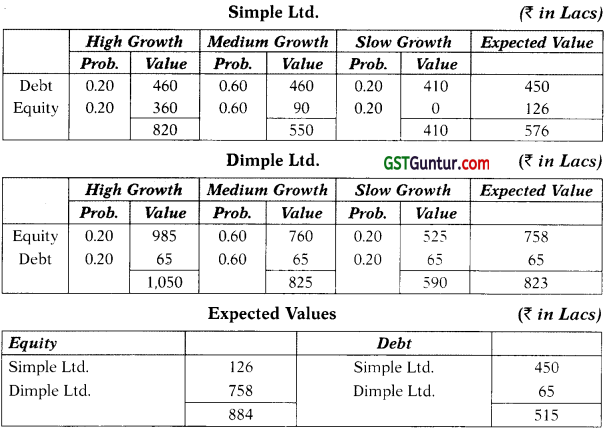
Question 31.
Yes Ltd. wants to acquire No Ltd. and the cash flows of Yes Ltd. and the merged entity are given below: (₹ in Lakhs)

Earnings would have witnessed 5% contestant growth rate without merger and 6% with merger on account of economies of operations after 5 years in each case. The cost of capital is 15%.
The number of shares outstanding in both the companies before the merger is the same and the companies agree to an exchange ratio of 0.5 shares of Yes Ltd. for each share of No Ltd.
PV factor at 15% for years 1-5 are 0.870,0.756,0.658,0.572,0.497 respectively. You are required to :
(i) Compute the Value of Yes Ltd. before and after merger.
(ii) Value of Acquisition and
(iii) Gain to shareholders of Yes Ltd. [Nov. 2012] [8 Marks]
Answer:
(i) Working Notes:
Present Value of Cash Flows (CF) upto 5 years

PV of Cash Flows of Yes Ltd. after the forecast period
TV5 = \(\frac{C F_5(1+g)}{K-g}=\frac{350(1+0.05)}{0.15-0.05}\) = \(\frac{367.50}{0.10}\) = ₹ 3,675 lakhs
PV of TV5 = ₹ 3,675 lakhs × 0.497 = ₹ 1,826.475 lakhs
PV of Cash Flows of Merged Entity after the forecast period
TV5 = \(\frac{C F_5(\mathrm{I}+g)}{K_c-g}\) = \(\frac{620(1+0.06)}{0.15-0.06}\) = \(\frac{657.20}{0.09}\) = ₹ 7,302.22 lakhs
PV of TV5 = ₹ 7,302.22 lakhs × 0.497 = ₹ 3,629.20 lakhs
Value of Yes Ltd.

(ii) Value of Acquisition
= Value of Merged Entity – Value of Yes Ltd.
= ₹ 5,308.47 lakhs – ₹ 2,708.915 lakhs = ₹ 2,599.555 lakhs
(iii) Gain to Shareholders of Yes Ltd.
Share of Yes Ltd. in merged entity = ₹ 5,308.47 lakhs × \(\frac{1}{1.5}\)
= ₹ 3,538.98 lakhs
Gain to shareholder = Share of Yes Ltd. in merged entity – Value of Yes Ltd. before merger
= ₹ 3,538.98 lakhs – ₹ 2,708.915 lakhs = ₹ 830.065 lakhs

Question 32.
M/s Tiger Ltd. wants to acquire M/s Leopard Ltd. The balance sheet of Leopard Ltd. as on 31st March, 2012 is as follows:

Additional information:
(i) Shareholders of Leopard Ltd. will get one share in Tiger Ltd. for every two shares. External liabilities are expected to be settled at ₹ 5,00,000. Shares of Tiger Ltd. would be issued at its current price of ₹ 15 per share. Debenture-holders will get 13% convertible debentures in the purchasing company for the same amount. Debtors and inventories are expected to realise ₹ 2,00,000.
(ii) Tiger Ltd. has decided to operate the business of Leopard Ltd. as a separate division. The division is likely to give cash flows (after tax) to the extent of ₹ 5,00,000 per year for 6 years. Tiger Ltd, has planned that, after 6 years, this division would be demerged and disposed of for ₹ 2,00,000.
(iii) The company’s cost of capital is 16%.
Make a report to the Board of the company advising them about the financial feasibility of this acquisition. [Nov. 2013] [10 Marks]

Answer:

Computation of Net Present Value

Since NPV of the decision is positive, it is advantageous to acquire Leopard Ltd.
Question 33.
The following is the Balance-Sheet of Grape Fruit Company Ltd. as at March 31st, 2011.
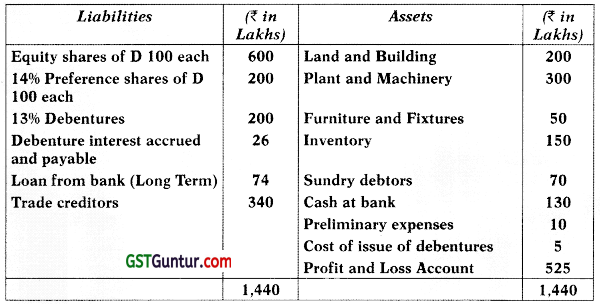
The Company did not perform well and has suffered sizable losses during the last few years. However, it is felt that the company could be nursed back to health by proper financial restructuring. Consequently the following scheme of reconstruction has been drawn up:
(i) Equity shares are to be reduced to ₹ 25 per share, fully paid up;
(ii) Preference shares are to be reduced (with coupon rate of 10%) to equal number of shares of ₹ 50 each, fully paid up.
(iii) Debenture holders have agreed to forego the accrued interest due to them. In the future, the rate of interest on debentures is to be reduced to 9 per cent.
(iv) Trade creditors will forego 25 per cent of the amount due to them.
(v) The company issues 6 lakh of equity shares at ₹ 25 each and the entire sum was to be paid on application. The entire amount was fully sub-scribed by promoters.
(vi) Land and Building was to be revalued at ₹ 450 lakhs, Plant and Machinery was to be written down by ₹ 120 lakhs and a provision of ₹ 15 lakhs had to be made for bad and doubtful debts.
Required:
(i) Show the impact of financial restructuring on the company’s activities. [Nov. 2011] [6 Marks]
(ii) Prepare the fresh balance sheet after the reconstruction is completed on the basis of the above proposals. [4 Marks]
Answer:
(1) Impact of Financial Restructuring
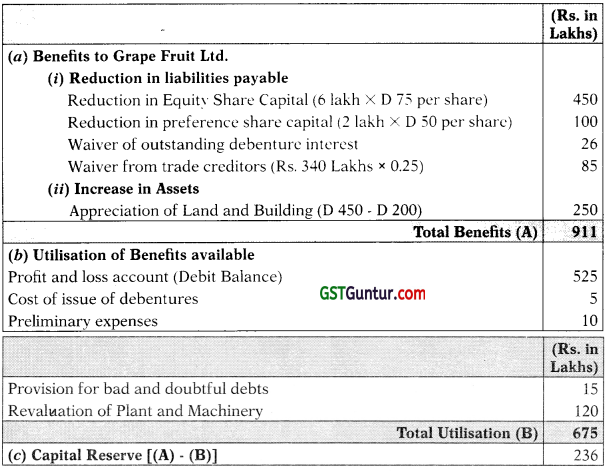
Balance Sheet of Grape Fruit Limited (after reconstruction)
As at 31st March, 2011
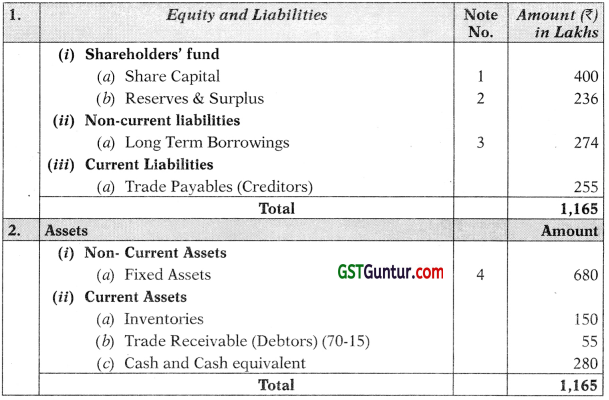
Notes to Accounts


Question 34.
The following is the Balance Sheet of XYZ Ltd. as at 31st March, 2016:
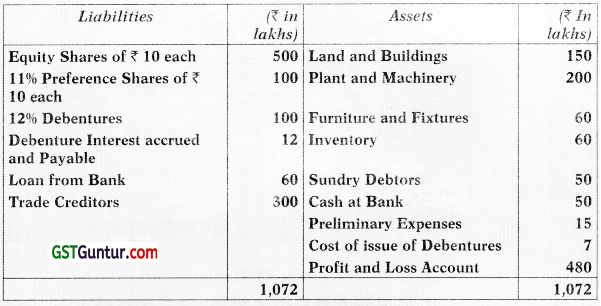
The Company’s performance is not good and has suffered sizable losses during the last few years. The Company can be nursed back to health with proper financial restructuring. As such, the following scheme is prepared:
(i) Equity Shares are to be reduced to ₹ 2 per Share, fully paid-up.
(ii) Preference Shares are to be reduced (with coupon Rate of 9%) to equal number of Shares of ₹ 5 each, fully paid-up.
(iii) Debenture holders have agreed to forgo the accrued interest due to them and for the future the rate of interest on Debentures to be 10%.
(iv) Trade Creditors will forgo 20% of the amount due to them.
(v) The Company to issue 50 Lakhs Shares at ₹ 2 each to be paid fully on Application. The entire amount is fully subscribed by Promoters.
(vi) Land and Building to be revalued at ₹ 350 Lakhs, Plant and Machinery value to be taken at ₹ 150 Lakhs and a provision of D 5 Lakhs to be made for Bad and Doubtful Debts.
You are required to :
(1) Show the impact of Financial Restructuring on the Company’s activities.
(2) Prepare the fresh Balance Sheet after the reconstruction is completed on the basis of above proposals. [May 2017] [8 Marks]
Answer:
(1) Impact of Financial Restructuring

Balance Sheet of XYZ Limited (after reconstruction)
As at 31st March, 2016
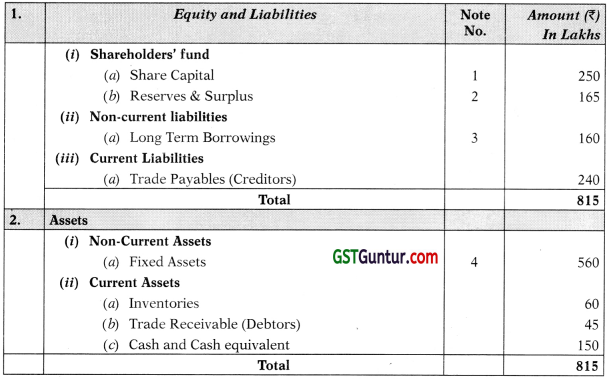
Notes to Accounts

Maximum Price to be offered for shares of Target Company

Question 35.
The equity shares of XYZ Ltd. are currently being traded at ₹ 24 per share in the market. XYZ Ltd. has total 10,00,000 equity shares outstanding in number; and promoters’ equity holding in the company is 40%. PQR Ltd. wishes to acquire XYZ Ltd. because of likely synergies. The estimated present value of these synergies is ₹ 80,00,000.
Further, PQR feels that management of XYZ Ltd. has been overpaid. With better motivation, lower salaries and fewer perks for the top management, will lead to savings of ₹ 4,00,000 p.a. Top management with their families are promoters of XYZ Ltd. Present value of these savings would add ₹ 30,00,000 in value to the acquisition.
Following additional information is available regarding PQR Ltd.:
Earnings per share: ₹ 4
Total number of equity shares outstanding: 15,00,000
Market price of equity share: ₹ 40
Required:
(i) What is the maximum price per equity share which PQR Ltd. can offer to pay for XYZ Ltd.?
(ii) What is the minimum price per equity share at which the management of XYZ Ltd. will be willing to offer their controlling interest? [May 2014] [4 + 2 = 6 Marks]
Answer:
(a) Calculation of maximum price per share at which PQR Ltd. can offer to pay for XYZ Ltd.’s share
| Market Value (10,00,000 × ₹ 24)
Synergy Gain
Saving of Overpayment |
₹ 2,40,00,000
₹ 80,00,000
₹ 30,00,000 |
| Total Benefits |
₹ 3,50,00,000 |
| Maximum Price (₹ 3,50,00,000 ÷ 10,00,000) |
₹ 35 |
(b) Calculation of minimum price per share at which the management of XYZ Ltd.’s will be willing to offer their controlling interest.
|
Amount (₹) |
| Value of XYZ Ltd.’s Mgt. Holding (40% of 10,00,000 × ₹ 24) |
96,00,000 |
| Add: PV of loss of remuneration to top management |
30,00,000 |
|
1,26,00,000 |
| No. of Shares |
4,00,000 |
| Minimum Price (₹ 1,26,00,000/4,00,000) |
₹ 31.50 |
Question 36.
BA Ltd. and DA Ltd. both the companies operate in the same industry. The Financial statements of both the companies for the current financial year are as follows:
Balance Sheet
| Particulars |
BA Ltd. (₹) |
DA Ltd. (₹) |
| Current Assets |
14,00,000 |
10,00,000 |
| Fixed Assets (Net) |
10,00,000 |
5,00,000 |
| Total (₹) |
24,00,000 |
15,00,000 |
| Equity capital (₹ 10 each) |
10,00,000 |
8,00,000 |
| Retained earnings |
2,00,000 |
– |
| 14% long-term debt |
5,00,000 |
3,00,000 |
| Current liabilities |
7,00,000 |
4,00,000 |
| Total (₹) |
24,00,000 |
15,00,000 |
Income Statement
|
|
DA Ltd. (₹) |
| Net Sales |
34,50,000 |
17,00,000 |
| Cost of Goods sold |
27,60,000 |
13,60,000 |
| Gross profit |
6,90,000 |
3,40,000 |
| Operating expenses |
2,00,000 |
1,00,000 |
| Interest |
70,000 |
42,000 |
| Earnings before taxes |
4,20,000 |
1,98,000 |
| Taxes @ 50% |
2,10,000 |
99,000 |
| Earnings after taxes (EAT) |
2,10,000 |
99,000 |
| Additional Information: |
|
|
| No. of Equity shares |
1,00,000 |
80,000 |
| Dividend payment ratio |
40% |
60% |
| Market price per share |
₹ 40 |
₹ 15 |
Assume that both companies are in the process of negotiating a merger through an exchange of equity shares. You have been asked to assist in establishing equitable exchange terms and are required to:
(i) Decompose the share price of both the companies into EPS and P/E components; and also segregate their EPS figures into Return on Equity (ROE) and book value/intrinsic value per share components.
(ii) Estimate future EPS growth rates for each company.
(iii) Based on expected operating synergies BA Ltd. estimates that the intrinsic value of DA’s equity share would be C 20 per share on its acquisition. You are required to develop a range of justifiable equity share exchange ratios that can be offered by BA Ltd. to the shareholders of DA Ltd. Based on your analysis in parts (i) and (ii), would you expect the negotiated terms to be closer to the upper, or the lower exchange ratio limits and why?
(iv) Calculate the post-merger EPS based on an exchange ratio of 0.4: 1 being offered by BA Ltd. and indicate the immediate EPS accretion or dilution, if any, that will occur for each group of shareholders.
(v) Based on a 0.4:1 exchange ratio and assuming that BA Ltd.’s pre-merger P/E ratio will continue after the merger, estimate the post-merger market price. Also show the resulting accretion or dilution in pre-merger market prices. . [Nov. 2008 (M)] [12 Marks]
Answer:
Market price per share (MPS) = EPS × P/E ratio or P/E ratio = MPS/EPS
(i) Determination of EPS, P/E ratio, ROE and BVPS of BA Ltd. and DA Ltd.
|
|
BA Ltd. (₹) |
DA Ltd. (₹) |
| Earnings After Tax(Given) |
A |
2,10,000 |
99,000 |
| No. of Shares(Given) |
B |
1,00,000 |
80,000 |
| EPS(A ÷ B) |
C |
2.10 |
1.2375 |
| Market price per share(Given) |
D |
40 |
15 |
| P/E Ratio(D ÷ C) |
E |
19.05 |
12.12 |
| Equity Fnnds(Given) |
F |
12,00,000 |
8,00,000 |
| BVPS(F ÷ B) |
G |
12 |
10 |
| ROE(A ÷ F) × 100 |
H |
17.50% |
12.37% |
(ii) Estimation of growth rates in EPS for BA Ltd. and DA Ltd.
|
|
BA Ltd. |
DA Ltd. |
| Retention Ratio |
(1 – D/P ratio) |
0.6 |
0.4 |
| Growth Rate |
(ROE × Retention Ratio) |
10.50% |
4.59% |
(iii) Justifiable Equity Shares Exchange Ratio
(a) Intrinsic value based = ₹ 20/₹ 40 = 0.5:1 (Upper limit)
(b) Market price based = MPSDA/MPSBA = ₹ 15/₹ 40 = 0.375:1 (Lower limit)
Since, BA Ltd. has a higher EPS, ROE, P/E ratio and even higher EPS growth expectations, the negotiable term should be expected to be closer to the lower limit based on the existing share prices.
(iv) Calculation of post-merger EPS and its effects

Working for calculation of EPS Dilution of DA Limited :
EPS Old = ₹ 1.2375
EPS claim as per Exchange Ratio = ₹ 2.34 × 0.4 = ₹ 0.936
EPS Dilution (₹ 1.2375 – ₹ 0.936) = ₹ 0.3015
(v) Estimation of Post-merger Market price and other effects
| Particulars |
BA Ltd. |
DA Ltd. |
Combined |
| EPS (₹) |
2.1 |
1.2375 |
2.341 |
| P/E Ratio |
19.05 |
12.12 |
19.05 |
| MPS (₹ ) [EPS ÷ P/E Ratio] |
40 |
15 |
44.6 |
| MPS Accretion (₹) |
4.6 |
2.84 See below |
|


Question 37
R Ltd. and S Ltd. are companies that operate in the same industry. The financial statements of both the companies for the current financial year are as follows:
Balance Sheet
| Particulars |
R Ltd. (₹) |
S Ltd. (₹) |
| Equity & Liabilities
Shareholders Fund Equity Capital (D10 each)
Retained earnings
Non-current Liabilities
16% Long term
Debt Current Liabilities |
20,00,000
4,00,000
10,00,000
14,00,000 |
16,00,000
–
6,00,000
8,00,000 |
| Total |
48,00,000 |
30,00,000 |
| Assets
Non-Current Assets Current Assets |
20,00,000
28,00,000 |
10,00,000
20,00,000 |
| Total |
48,00,000 |
30,00,000 |
Income Statement
| Particulars |
R Ltd. (₹) |
S Ltd. (₹) |
| A. Net Sales
B. Cost of Goods sold |
69,00,000
55,20,000 |
34,00,000
27,20,000 |
| C.Gross Profit (A-B) |
13,80,000 |
6,80,000 |
D. Operating Expenses
E. Interest |
4,00,000
1,60,000 |
2,00,000
96,000 |
| F. Earnings before taxes [C-(D+E)] |
8,20,000 |
3,84,000 |
| G. Taxes @ 35%
H. Earnings After Tax (EAT) |
2.87.000
5.33.000 |
1,34,400
2,49,600 |
Additional Information:
| No. of equity shares |
2,00,000 |
1,60,000 |
| Dividend Payment Ratio (D/P) |
20% |
30% |
| Market price per share |
₹ 50 |
₹ 20 |
Assume that both companies are in the process of negotiating a merger through exchange of Equity shares:
You are required to:
(i) Decompose the share price of both the companies into EPS & P/E components. Also segregate their EPS figures into Return on Equity (ROE) and Book Value/Intrinsic Value per share components.
(ii) Estimate future EPS growth rates for both the companies.
(iii) Based on expected operating synergies, R Ltd. estimated that the intrinsic
value of S Ltd. Equity share would be D 25 per share on its acquisition. You are required to develop a range of justifiable Equity Share Exchange ratios that can be offered by R Ltd. to the shareholders of S Ltd. Based on your analysis on parts (i) and (ii), would you expect the negotiated terms to be closer to the upper or the lower exchange ratio limits and why? [May 2015]
Answer:
(i) Determination of various values
| Particulars |
R Ltd. |
S Ltd. |
| (a) Earnings after Tax |
Rs. 5,33,000 |
Rs. 2,49,600 |
| (b) No.of shares |
2,00,000 |
1,60,000 |
| (c) Equity/Net Assets (20 Lakhs + 4 Lakhs ) |
Rs. 24,00,000 |
Rs. 16,00,000 |
| (d) MPS |
Rs. 50 |
Rs. 20 |
| (e) EPS |
Rs. 2.665 |
Rs. 1.56 |
| (f) P/E Ratio (d/e) |
18.76 times |
12.82 times |
| (g) ROE (a/c x 100) |
22.21% |
15.6% |
| (h) Book Value (c/b) |
Rs. 12 |
Rs. 10 |
(ii) Determination of Growth Rate of EPS of R Ltd. and S Ltd.
| Particulars |
R Ltd. |
S Ltd. |
| Retention Ratio (1 – D/P Ratio) |
0.80 |
0.70 |
| Growth Rate (ROE × Retention Ratio) |
0.1777 |
0.1092 |
| Growth Rate (in percentage) |
17.77% |
10.92% |
(iii) Justifiable equity share exchange ratio
| Market Price Based |
|
|
| MPSs÷ MPSB = Rs. 20/Rs. 50 |
0.41: 1 |
Lower Limit |
| Intrinsic Value Based |
|
|
| = Rs. 25/Rs. 50 |
0.50: 1 |
Max. Limit |
Since R Ltd. has higher EPS, PE, ROE and higher growth expectations the negotiated term would be expected to be closer to the lower limit, based on existing share price.

Question 38.
R Ltd, and S Ltd. operating in same industry are not experiencing any rapid growth but providing a steady stream of earnings. R Ltd.’s management is interested in acquisition of S Ltd. due to its excess plant capacity. Share of S Ltd, is trading in market at ₹ 3.20 each. Other data relating to S Ltd. is as follow:
Balance sheet of S Ltd.

Other Information

You are required to compute the following:
(a) Minimum price per share S Ltd. should accept from R Ltd.
(b) Maximum price per share R Ltd. shall be willing to offer to S Ltd.
(c) Floor value of per share of S Ltd., whether it shall play any role in decision for its acquisition by R Ltd. [May 2019 Old Syllabus] [8 Marks]
Answer:
|
R |
S |
Combined |
| MP per share |
|
3.2 |
|
| Number of shares |
|
80 lakhs |
|
| Paid up value per share |
|
1.5 |
|
| Reserves |
|
279,95,000 |
|
| PAT |
86,50,000 |
49,72,000 |
121,85,000 |
| Net cash flows per year |
90,10,000 |
54,87,000 |
185,00,000 |
| Ke |
13.75 |
13.05 |
12.5 |
1. Minimum Price per share payable by R to S Ltd.
Minimum Value payable by R to S is Pre-merger value to S Ltd, But if Pre Merger value is value is less than book value, R will pay Book value to S.
Pre Value of S Ltd. = 80,00,000 × 3.2 = ₹ 2,56,00,000
Book Value of S Ltd. = (80,00,000 × 1.5) + (2,79,95,000) = ₹ 3,99,95,000
Minimum price per share payable to S Ltd. = \(\frac{3,99,95,000}{80,00,000}\) = ₹ 4.99 or ₹ 5 per share
2. Maximum Price per share payable to S Ltd.
Value of combined firm after acquisition (i.e. Present value of all future
cash inflows of combined firm) = \(\frac{R s .185,00,000}{0.125}\) = ₹ 1480,00,000
Pre value of R Ltd. = \(\frac{R s \cdot 90,10,000}{0.1375}\) = ₹ 6,55,27,273
Value given to S Ltd. = ₹ 8,24,72,727
Value Per share = \(\frac{R s .824,72,727}{80,00,000}/latex] = ₹ 10.31
Floor value for S Ltd. (Per share) = ₹ 3.20
It shall not play any role in decision for the acquisition of S Ltd. as it is lower than its current book value
Question 39.
Elrond Limited plans to acquire Doom Limited. The relevant financial details of the two firms prior to the merger announcement are:
|
Elrond Limited |
Doom Limited |
| Market price per share |
₹ 50 |
₹ 25 |
| Number of outstanding shares |
20 lakhs |
10 lakhs |
The merger is expected to generate gains, which have a present value of ₹ 200 lakhs. The exchange ratio agreed to 0.5.
What is the true cost of the merger from the point of view of Elrond Limited? [Nov. 2014] [5 Marks]
Answer:
(a) Shares to be issued by Elrond Limited:
= No. of shares in Doom Ltd. ₹ Exchange Ratio
= 10 Lakhs ₹ 0.5 = 5 Lakh Shares
(b) Percentage holding of shareholders of Doom Ltd. in Elrond Limited:
= [latex]\frac{5 \text { lakh }}{20 \text { lakh }+5 \text { lakh }}\) i.e. 20%
(c) The value of Elrond Ltd. after merger:
= (₹ 50 × 20 lakh) + (₹ 25 × 10 lakh) + ₹ 200 lakh
= ₹ 1,000 lakh + ₹ 250 lakh + ₹ 200 lakh = ₹ 1,450 lakh
Value for shareholders of Doom Ltd. = ₹ 1,450 × 20% = ₹ 290 lakhs
(d) True Cost of Merger will be:
= ₹ 290 lakhs – ₹ 250 lakhs = ₹ 40 lakhs

Question 40.
Given is the following information:
|
Day Ltd. |
Night Ltd. |
| Net Earnings |
₹ 5 crores |
₹ 3.50 Crores |
| No. of Equity Shares |
10,00,000 |
7,00,000 |
The shares of Day Ltd. and Night Ltd. are traded with P/E ratios 20 and 15 times respectively. The Day Ltd. considers taking over Night Ltd. by paying ₹ 55 crores considering that the market price of Night Ltd. reflects its true value. It is considering both the following options:
(i) Takeover is funded entirely in cash.
(ii) Takeover is funded entirely in stock.
You are required to calculate the cost of the takeover and advise Day Ltd. on the best alternative. [May 2019] [8 Marks]
Answer:
Calculation of EPS and MPS
|
Day Ltd. |
Night Ltd. |
| EPS |
\(\frac{\text { Rs.3.5 Crores }}{7 \text { Lakhs }}\) = ₹ 50 |
\(\frac{\text { Rs.3.5 Crores }}{7 \text { Lakhs }}\) = ₹ 50 |
| P/E Ratio |
20 |
15 |
| MPS (P/E Ratio X EPS) |
₹ 1,000 |
₹ 750 |
| Market Capitalisation (No. of Shares X MPS) |
10 Lakhs × 1,000 = ₹ 100 Crores |
7 Lakhs 750 = ₹ 52.50 Crores |
(a) If takeover is funded entirely in CASH:
True Cost of Merger = Amount paid to Vendor Co. – Pre-Value of Vendor Company
= ₹ 55 Crores – ₹ 52.5 Crores = ₹ 2.5 Crores
(b) If takeover is funded entirely in STOCK:
Amount Payable = ₹ 55 Crores
Market Price per Share (Acquirer) = ₹ 1,000
No. of shares to be issued = \(\frac{\text { Rs.55 Crores }}{R s .1,000}\) = 5,50,000 Shares
Therefore, the shareholders of Night Limited will get 5,50,000 shares of Day Limited
Market Value of Merged Firm = Rs. 1,00,00,00,000 + Rs. 52,50,00,000
= Rs. 1,52,50,00,000 i.e. Rs. 152.50 Crore
Proportion that Night Ltd.’s shareholders get in Day Ltd.’s Capital Structure will be:
\(\frac{5.5 \text { Lakhs }}{5.5 \text { Lakhs }+10 \text { Lakhs }}\) = 0.3548
True Cost of Merger = Rs. 152.50 Crore × 0.3548 – Rs. 55 Crore
= Rs. (-) 8.93 Crore
Since true cost is negative in case of funding from stock, Day Ltd. would better off by funding the takeover by stock.
Question 41.
B Ltd., is a highly successful company and wishes to expand by acquiring other firms. Its expected high growth in earnings and dividends is reflected in its PE ratio of 17. The Board of Directors of B Ltd. has been advised that if it were to takeover firms with a lower PE ratio than it own, using a share- for-share exchange, then it could increase its reported earnings per share. C Ltd. has been suggested as a possible target for a takeover, which has a PE ratio of 10 and 1,00,000 shares in issue with a share price of ₹ 15. B Ltd. has
5,0, 000 shares in issue with a share price of ₹ 12.
Calculate the change in earnings per share of B Ltd. if it acquires the whole of C Ltd. by issuing shares at its market price of ₹ 12. Assume the price of B Ltd. shares remains constant. [Nov. 2014][8 Marks]
Answer:
| Total market value of C Ltd. (1,00,000 × ₹ 15) |
₹ 15,00,000 |
| PE ratio (given) |
10 |
| Therefore, earnings |
15,00,000/10 |
|
1,50,000 |
| Total market value of B Ltd. (5,00,000 × ₹ 12) |
60,00,000 |
| PE ratio (given) |
17 |
| Therefore, earnings |
60,00,000/17 |
|
3,52,941 |
| The number of shares to be issued by B Ltd. |
|
| ₹ 15,00,000 × 12 |
1,25,000 |
| Total number of shares of B Ltd. |
5,00,000 + 1,25,000 = 6,25,000 |
| The EPS of the new firm is |
(₹ 3,52,941 + ₹ l,50,000)/6,25,000 |
|
0.80 |
| The present EPS of B Ltd. is |
3,52,941/5,00,000 |
|
0.71 |
So the EPS affirm B will increase from ₹ 0.71 to ₹ 0.80 as a result of merger.

Question 42.
ABC Co. is considering a new sales strategy that will be valid for the next 4 years. They want to know the value of the new strategy. Following information relating to the year which has just ended, is available:
| Income Statement |
₹ |
| Sales |
20,000 |
| Gross margin (20%) |
4,000 |
| Administration, Selling & distribution expense (10%) |
2,000 |
| PBT |
2,000 |
| Tax (30%) |
600 |
| PAT |
1,400 |
| Balance Sheet Information |
|
| Fixed Assets |
8,000 |
| Current Assets |
4,000 |
| Equity |
12,000 |
If it adopts the new strategy, sales will grow at the rate of 20% per year for three years. The gross margin ratio, Assets turnover ratio, the Capital structure and the income tax rate will remain unchanged.
Depreciation would be at 10% of net fixed assets at the beginning of the year. The Company’s target rate of return is 15%.
Determine the incremental value due to adoption of the strategy. [May 2007] [8 Marks]
Answer:
Projected Balance Sheet

Projected Cash Flows

Present Value of Projected Cash Flows
| Cash Flows |
PV at 15% |
PV |
| -720 |
0.870 |
-626.40 |
| -864 |
0.756 |
-653.18 |
| -1,036.80 |
0.658 |
-682.21 |
|
|
-1,961.79 |
Residual Value = \(\frac{2,419.20}{0.15}\) = ₹ 16,128
Present value of Residual value = \(\frac{16,128}{(1.15)^3}\) = \(\frac{16,128}{1.521}\) = 10603.55
Total shareholders’ value = 10,603.55 – 1,961.79 = 8,641.76
Pre strategy value = 1,400/0.15 = 9,333.33
∴ Value of strategy = 8,641.76 – 9,333.33 = (691.57)
Conclusion:
The strategy is not financially viable

Question 43.
Helium Ltd. has evolved a new sales strategy for the next 4 years. The following information is given:
| Income Statement |
₹ in thousands |
| Sales |
40,000 |
| Gross Margin at 30% |
12,000 |
| Accounting, administration and distribution expense at 15% |
6,000 |
| Profit before tax |
6,000 |
| Tax at 30% |
1,800 |
| Profit after tax |
4,200 |
| Balance sheet information |
₹ in thousands |
| Fixed Assets |
10,000 |
| Current Assets |
6,000 |
| Equity |
15,000 |
As per the new strategy, sales will grow at 30 per cent per year for the next four years. The gross margin ratio will increase to 35 per cent. The Assets turnover ratio and income tax rate will remain unchanged.
Depreciation is to be at 15 per cent on the value of the net fixed assets at the beginning of the year.
Company’s target rate of return is 14%.
Determine if the strategy is financially viable in cases:
Case (a) C. Liabilities are ₹ 1000 (thousands)
Case (b) There is no current liability & equity is assumed to be ₹ 16,000 (thousand) [Nov. 2011] [10 Marks]
Answer:
Case I C. Liabilities are ₹ 1000 (thousands)
Projected Balance Sheet

Projected Cash Flows
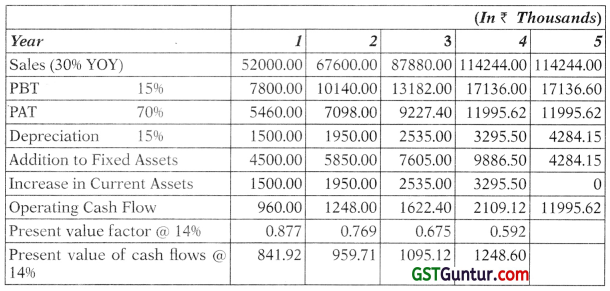
|
(In ₹ Thousands) |
| Total for first 4 years (A) |
4145.35 |
| Residual value (11995.62/0.14) |
85683 |
| Present value of Residual value [85683/(1.14)4] (B) |
50731.21 |
| Total Shareholders value (C) = (A) + (B) |
54876.56 |
| Pre strategy value (4200/0.14) (D) |
30000.00 |
| Value of strategy (C) – (D) |
24876.56 |
Conclusion: The strategy is financially viable.
Case II There is no C. Liabilities & Equity is ₹ 16,000

|
(In ₹ Thousands) |
| Total for first 4 years (A) |
3113.03 |
| Residual value (6225.73/0.14) |
44469.50 |
| Present value of Residual value [44469.50/(1.14)4] (B) |
26329.51 |
| Total Shareholders’ value (C) = (A) + (B) |
29442.54 |
| Pre strategy value (4200/0.14) (D) |
30000.00 |
| Value of strategy (C) – (D) |
-557.46 |

Question 44.
Following details are available for X Ltd.
Income statement for the year ended 31st March, 2018
| Particulars |
Amount |
| Sales |
40,000 |
| Gross profit |
12,000 |
| Administrative Expenses |
6,000 |
| Profit before tax |
6,000 |
| Tax @ 30% |
1,800 |
| Profit After Tax |
4,200 |
Balance sheet as on 31st March, 2018
| Assets |
Amount |
| Fixed Assets |
10,000 |
| Current Assets |
6,000 |
| Total Assets |
16,000 |
| Liabilities |
Amount |
| Equity share capital |
15,000 |
| Sundry creditors |
1,000 |
| Total liabilities |
16,000 |
The company is contemplating for new sales strategy as follows:
(i) Sales to grow at 30% per year for next four years.
(ii) Assets turnover ratio, net profit ratio and tax rate will remain the same.
(iii) Depreciation will be 15% of value of net fixed assets at the beginning of the year.
(iv) Required rate of return for the company is 15%.
Evaluate the viability of new strategy. [Nov. 2018] [12 Marks]
Answer:
Step 1 Preparation of Projected Balance Sheet of X Ltd.

Step 2 Determination of Present Value of Projected Cash Flows
Projected Cash Flows:-

Present value of Projected Cash Flows:-
| Cash Flows |
PVF at 15% |
PV |
| 960 |
0.870 |
835.20 |
| 1248 |
0.756 |
943.49 |
| 1622.40 |
0.658 |
1067.54 |
| 2109.12 |
0.572 |
1206.42 |
|
|
4,052.65 |
Step 3 Determination of Value of Strategy:
Residual Value = 11,995.62/0.15 = 79,970.80
Present value of Residual value = 79.970.80 × PVF (15%, 4) = 79,970.80 × 0.572 = 45,743.30
Total shareholders value = 45743.30 + 4052.65 = 49795.95
Pre-strategy value = 4200/0.15 = 28,000
Value of strategy = 49795.95 – 28,000 = 21795.95
Conclusion: The strategy is financially viable.

Question 45.
The following information is relating to Fortune India Ltd. having two divisions, viz. Pharma Division and Fast Moving Consumer Goods Division (FMCG Division). Paid up share capital of Fortune India Ltd. is consisting of 3,000 Lakhs equity shares of Re. 1 each. Fortune India Ltd. decided to de-merge Pharma Division as Fortune Pharma Ltd. w.e.f. 1.4.2009. Details of Fortune India Ltd. as on 31.3.2009 and of Fortune Pharma Ltd. as on 1.4.2009 are given below:
| Particulars |
Fortune Pharma Ltd. (₹) |
Fortune India Ltd. (₹) |
| Outside Liabilities |
|
|
| Secured Loans |
400 lakh |
3,000 lakh |
| Unsecured Loans |
2,400 lakh |
800 lakh |
| Current Liabilities & Provisions |
1,300 lakh |
21,200 lakh |
| Assets |
|
|
| Fixed Assets |
7,740 lakh |
20,400 lakh |
| Investments |
7,600 lakh |
12,300 lakh |
| Current Assets |
8,800 lakh |
30,200 lakh |
| Loans & Advances |
900 lakh |
7,300 lakh |
| Deferred tax/Misc. Expenses |
60 lakh |
(200) lakh |
Board of Directors of the Company have decided to issue necessary equity shares of Fortune Pharma Ltd. of Re. 1 each, without any consideration to the shareholders of Fortune India Ltd. For that purpose following points are to be considered:
(a) Transfer of Liabilities & Assets at Book value.
(b) Estimated Profit for the year 2009-10 is ₹ 11,400 Lakh for Fortune India Ltd. & ₹ 1,470 lakhs for Fortune Pharma Ltd.
(c) Estimated Market Price of Fortune Pharma Ltd. is ₹ 24.50 per share.
(d) Average P/E Ratio of FMCG sector is 42 & Pharma sector is 25, which is to be expected for both the companies.
Calculate:
1. The Ratio in which shares of Fortune Pharma are to be issued to the shareholders of Fortune India Ltd.
2. Expected Market price of Fortune India Ltd.
3. Book Value per share of both the Companies immediately after Demerger. [Nov. 2005] [8 Marks]
Answer:
Determination of Shareholder’s funds (₹ in Lakhs)
| Particulars |
Fortune India Ltd. |
Fortune Pharma Ltd. |
Fortune India (FMCG) Ltd. |
| Assets |
70,000 |
25,100 |
44,900 |
| Outside liabilities |
25,000 |
4,100 |
20,900 |
| Net worth |
45,000 |
21,000 |
24,000 |
1. Calculation of Shares of Fortune Pharma Ltd. to be issued to shareholders of Fortune India Ltd.
|
Fortune Pharma Ltd. |
| Estimated Profit (₹ in lakhs) |
1,470 |
| Estimated market price (₹) |
24.5 |
| Estimated P/E |
25 |
| Estimated EPS (₹) |
0.98 |
| No. of shares lakhs |
1,500 |
Hence, Ratio is 1 share of Fortune Pharma Ltd. for 2 shares of Fortune India Ltd.
2. Expected market price of Fortune India Ltd.
|
Fortune India (FMCG) Ltd. |
| Estimated Profit (₹ in lakhs) |
11,400 |
| No. of equity shares (₹ in lakhs) |
3,000 |
| Estimated EPS (₹) |
3.8 |
| Estimated P/E |
42 |
| Estimated market price (₹) |
159.60 |
3. Book value per share
|
Fortune Pharma Ltd. |
Fortune India (FMCG) Ltd. |
| Net worth (₹ in lakhs) |
21,000 |
24,000 |
| No. of shares (₹ in lakhs) |
1,500 |
3,000 |
| Book value of shares |
₹ 14 |
₹ 8 |

Question 46.
AB Ltd. has recently approached the shareholders of CD Ltd. which is engaged in the same line of business as that of AB Ltd. with a bid of 4 news shares in AB Ltd. for every 5 CD Ltd. shares or a cash alterative of ₹ 360 per share. Past records of earnings of CD Ltd. had been poor and the company’s shares have been out of favour with the stock market for some time.
Pre-bid information for the year ended 31.3.2006 are as follows:
|
AB Ltd. in Lakhs |
CD Ltd. in Lakhs |
| Equity share capital |
60 |
170 |
| Number of shares |
24 |
17 |
| Pre-tax profit |
125 |
110 |
| P/E Ratio |
11 |
7 |
| Estimated post tax cost of Equity Capital per Annum |
12% |
10% |
Both AB Ltd. and CD Ltd. pay income tax at 30%. Current earnings growth forecast is 4% for the foreseeable future of both the Companies.
Assuming no synergy exists, you are required to evaluate whether proposed share to share offer is likely to be beneficial to the shareholders of both the companies using merger terms available. AB Ltd.’s directors might expect their own pre-bid P/E ratio to be applied to combined earnings.
Also comment on the value of the two Companies from the constant growth form of dividend valuation model assuming all earnings are paid out as dividends. [Nov. 2007] [14 Marks]
Answer:
Alternative 1 (when number of shares are 2.4 and 1.7 lakhs respectively) Background calculations for Evaluation: (Figures in lakhs)
|
AB Ltd. |
CD Ltd. |
Total |
| PBT |
125 |
110 |
235 |
| PAT |
87.5 |
77 |
164.5 |
| Prc bid EPS |
36.45 |
45.29 |
|
| P/E ratio |
11 |
7 |
|
| Pre-bid Price Per Share |
401.06 |
317.03 |
|
| Market value of the company |
962.54 |
538.95 |
1,501.49 |
| No. of New Shares Post bid |
2.4 |
1.36 |
3.76 |
| % combined company owned by |
63.83% |
36.17% |
|
| Value to the original Shareholders |
958.40 |
543.09 |
1,501.49 |
| Post bid Price per share to original shareholders i.e., 2.40 lakhs and 1.70 lakhs shareholders respectively. |
399.33 |
319.46 |
|
(Note: The Post bid Price per share to new shareholders as per terms of acquisition works out to ₹ 399.33 for both the companies)
These figures suggest post bid acquisition share price of ₹ 399.33 for AB Ltd., and 319.46 for CD Ltd.’s original shareholders. The price of CD Ltd. share is likely to be influenced by the value of cash alternative.
The post bid share price of the new firm can be estimated by applying the P/E ratio to the combined earnings of the two old companies.
In that case,
Market Value would be = 164.5 × 11 = 1809.50
Price per share of the combined company would be = \(\frac{1,809.50}{3.76}\) = ₹ 481.25
∴ Therefore share of AB Ltd., shareholders would rise by ₹ 481.25 – ₹ 401.06 = ₹ 80.19 i.e., 20%.
Share value of CD Ltd., shareholder expected to rise by
(₹ 481.25 × \(\frac{4}{5}\)) – 317.03 = ₹ 67.97 i.e. 21.44%
With the cash offer the premium is \(\frac{360-317.03}{317.03}\) = 13.55% only
Hence shareholders of CD Ltd. are gaining more from the merger in a share exchange and cash alternative is unlikely to be accepted.
Using constant growth model the value of both the individual companies would be:
AB Ltd., share price = \(\frac{36.46(1.04)}{0.12-0.04}\) = ₹ 473.98
CD Ltd., share price = \(\frac{45.29 \times 1.04}{0.10-0.04}\) = ₹ 785.03
On this basis market slightly undervalues AB Ltd. share but share of CD Ltd., are highly undervalued possibly because of previous disappointments. However, if AB Ltd. forecast is believed that the AB Ltd., is getting CD Ltd. shares, it will be a cheap proposal for AB Ltd. to acquire the CD Ltd. on share exchange basis and especially if any of the shareholder of CD Ltd. Accept the cash offer.
The shareholders of CD Ltd. would also be benefited post merger based on share exchange ratio since the value of their share would be going up from ₹ 317.03 to ₹ 399.33. However, their share price would still be undervalued as compared with the share price calculated by using constant growth model.
Alternative 2 (when number of shares are 24 and 17 lakhs respectively)
If we take into consideration the number of shares being 24 lakhs and 17 lakhs the Pre-bid share price works out to ₹ 40.15 and ₹ 31.71 respectively, which seems to be illogical against a cash offer @ ₹ 360 per share. However, since many students may have solved this question based on the figures of 24 lakhs and 17 lakhs number of shares, an alternative solution is provided below.
| Evaluation: |
|
. |
Figure in lakhs |
| Background calculations: |
AB Ltd. |
CD Ltd. |
Total |
| PBT |
125 |
110 |
225 |
| PAT |
87.5 |
77 |
164.5 |
| Pre-bid EPS |
3.65 |
4.53 |
|
| P/E Ratio |
11 |
7 |
|
| Pre-bid Price per share |
40.15 |
31.71 |
|
| Market value of the company |
963.60 |
539.07 |
1502.67 |
| No. of new shares Post-bid |
24 |
13.6 |
37.6 |
| % of combined company owned by |
63.83 |
36.17 |
|
| Value to the original shareholders |
959.15 |
543.52 |
1502.67 |
| Post-bid Price to original shareholders i.e., 24 lakhs and 17 lakhs shareholders respectively |
39.96 |
31.97 |
|
(Note: The Post bid price per share works out to ₹ 39.96 for both the companies)
These figures suggest Post acquisition share price of ₹ 39.96 for AB Ltd. and ₹ 31.97 for CD Ltd’s original shareholders. The Price of CD Ltd. Share is likely to be influenced by the value of cash alternative.
The Post bid share price of the new firm can be estimated by applying the P/E ratio to the combined earnings of the two old companies.
In that case,
Market-value would be = 164.5 × 11 = 1809.50
Price per share of the combined company
Would be = \(\frac{1809.50}{37.6}\) = 48.13
∴ Shares of AB Ltd. shareholders would raise by ₹ 48.13 – 40.15 = 7.98 i.e., 19.87% or 20%.
Share value of CD Ltd., shareholders expected to raise by (₹ 48.13 × \(\frac{4}{5}\)) – 31.71 = ₹ 7.40 or 23.34%.
However, with the cash offer the premium is \(\frac{360-31.71}{31.71}\) = 1035.29%
Hence, the shareholders of CD Ltd., are substantially benefited by cash offer and they are unlikely to accept the share swap ratio.
Using constant growth model the value of shares of both the individual companies would be
AB Ltd. Share Price = \(\frac{3.65(1.04)}{0.12-0.04}=\frac{3.80}{0.08}\) = ₹ 47.5
CD Ltd. Share Price = \(\frac{4.53(1.04)}{0.10-0.04}=\frac{4.71}{0.06}\) = ₹ 78.5
On this basis market slightly undervalues AB Ltd. Share but share of CD Ltd., is highly undervalued possibly because of previous disappointments. However, if AB Ltd. forecast is believed that the AB Ltd. is getting CD Ltd. share it will be a cheap proposal for AB Ltd., to acquired CD Ltd., on share exchange basis.
The shareholders of CD Ltd., would however be more benefited by cash offer.
Note: The above answer is based upon the solution given by ICAI in their suggested answers.
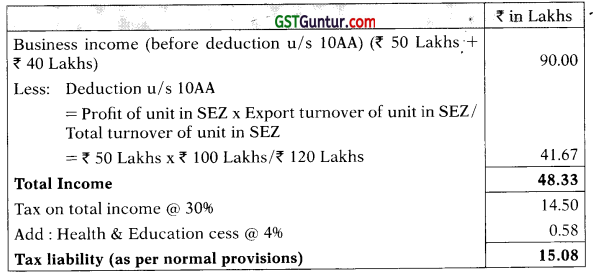

![]()





![]()

![]()


![]()
![]()




